Search Result
Results for "
penetration
" in MedChemExpress (MCE) Product Catalog:
4
Biochemical Assay Reagents
3
Isotope-Labeled Compounds
| Cat. No. |
Product Name |
Target |
Research Areas |
Chemical Structure |
-
- HY-102032
-
|
|
Adrenergic Receptor
|
Endocrinology
|
|
Butyryltimolol, an effective precursor of Timolol, improves the corneal penetration of Timolol . Butyryltimolol is a β-adrenergic blocker .
|
-
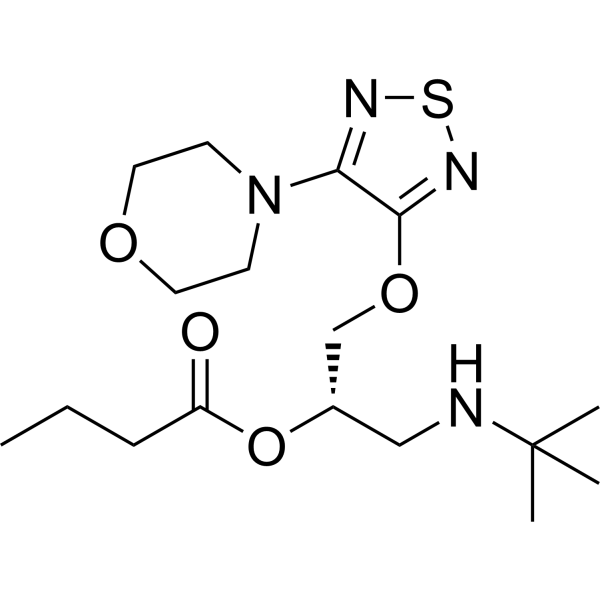
-
- HY-129060
-
|
|
Fungal
|
Infection
|
|
Flutrimazole is an imidazole antifungal with dual anti-inflammatory and antifungal activity. Flutrimazole shows scarce transdermal penetration. Flutrimazole has the advantageous in the research of topical fungal infections with an inflammatory component .
|
-

-
- HY-A0147A
-
|
OPC-17116 hydrochloride; dl-Grepafloxacin hydrochloride
|
Antibiotic
Bacterial
|
Infection
|
|
Grepafloxacin (OPC-17116) hydrochloride is an oral actively fluoroquinolone antibiotic with potent activity against community-acquired respiratory pathogens including Streptococcus pneumonia. Grepafloxacin hydrochloride has high tissue penetration and a promising pharmacodynamic profile .
|
-
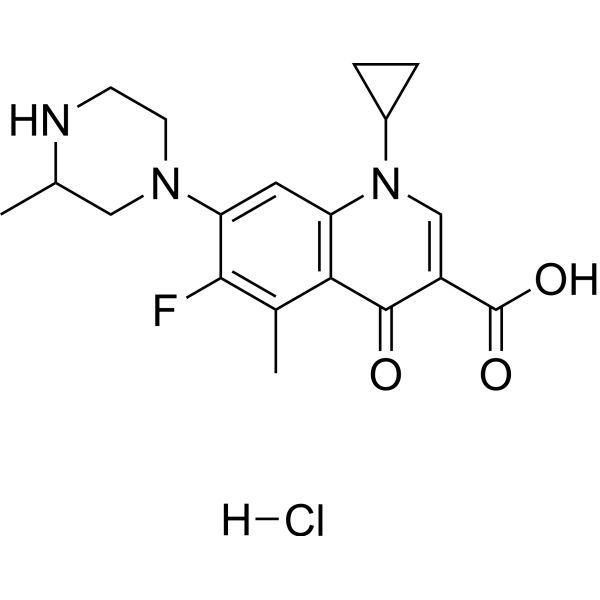
-
- HY-102032A
-
|
|
Adrenergic Receptor
|
Others
|
|
(RS)-Butyryltimolol is the racemate of Butyryltimolol. Butyryltimolol, an effective proagent of Timolol, improves the corneal penetration of Timolol . Butyryltimolol is a β-adrenergic blocker .
|
-
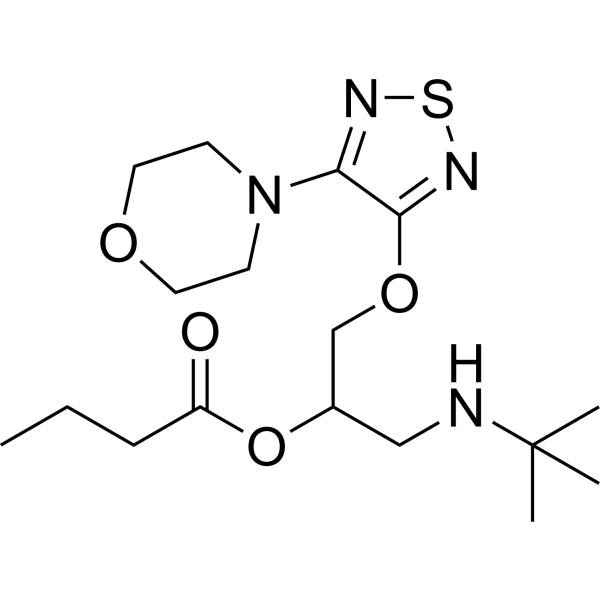
-
- HY-147013
-
|
|
Influenza Virus
Orthopoxvirus
|
Infection
|
|
Caprochlorone has antiviral activity against orthopoxvirus. Caprochlorone can inhibit cell penetration by virus, also delays release of newly formed virus from the cell. Caprochlorone decreases the titers of influenza virus in infected-mice lungs .
|
-
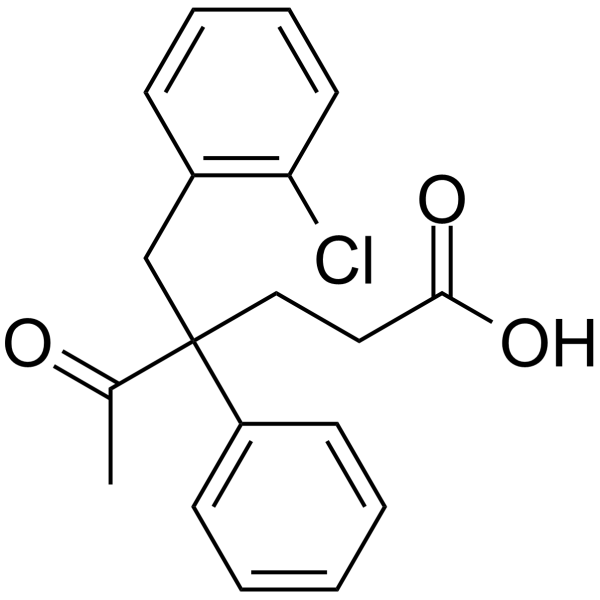
-
- HY-116625
-
|
|
GHSR
|
Neurological Disease
|
|
PF-04628935 (compound 10n) is a potent ghrelin receptor inverse agonist, with an IC50 of 4.6 nM. PF-04628935 exhibits oral bioavailability of 43% in rats and shows reasonable penetration into the brain. PF-04628935 can be used for stress and anxiety research .
|
-
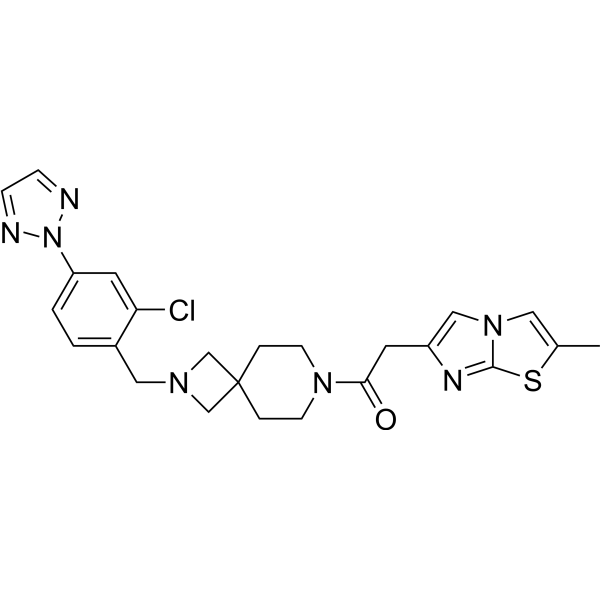
-
- HY-138879
-
|
|
nAChR
|
Neurological Disease
|
|
CP-601927 is a selective α4β2 nicotinic acetylcholine receptor (nAChR) partial agonist (Ki=1.2 nM; EC50=2.6 μM). CP-601927 shows good brain penetration and antidepressant-like properties .
|
-

-
- HY-139322
-
|
|
Biochemical Assay Reagents
|
Others
|
|
PEG-8 laurate is a single chain surfactant. PEG-8 laurate reduces the skin barrier, and acts as a penetration enhancer. PEG-8 laurate can be used to synthesize elastic vesicles .
|
-
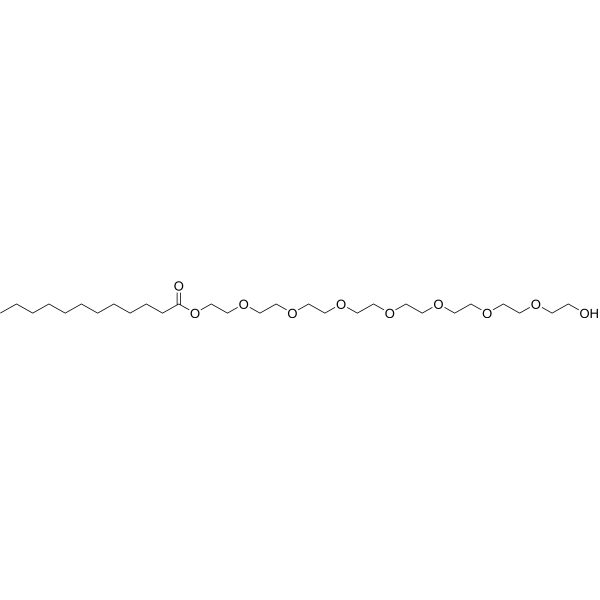
-
- HY-P9967
-
|
BIIB037
|
Amyloid-β
|
Neurological Disease
|
|
Aducanumab (BIIB037) is a human monoclonal antibody that selectively targets aggregated amyloid-beta (Aβ). Aducanumab shows brain penetration, and can be used for Alzheimer's disease (AD) research .
|
-

-
- HY-144696
-
|
|
DYRK
|
Neurological Disease
|
|
Dyrk1A/α-synuclein-IN-2 (Compound b20) is a dual Dyrk1A and α-synuclein aggregation inhibitor with an IC50 of 7.8 µM for α-synuclein. Dyrk1A/α-synuclein-IN-2 has high predictive CNS penetration and neuroprotective effect .
|
-
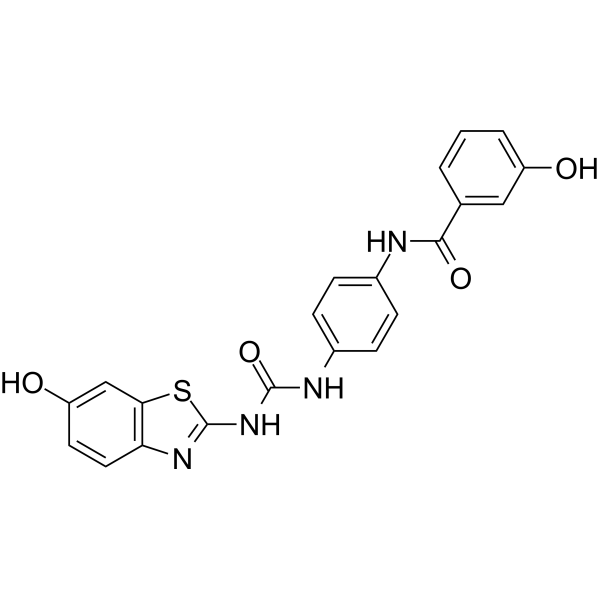
-
- HY-144695
-
|
|
DYRK
|
Neurological Disease
|
|
Dyrk1A/α-synuclein-IN-1 (Compound b1) is a dual Dyrk1A and α-synuclein aggregation inhibitor with IC50 values of 177 nM and 10.5 µM, respectively. Dyrk1A/α-synuclein-IN-1 has high predictive CNS penetration and neuroprotective effect .
|
-
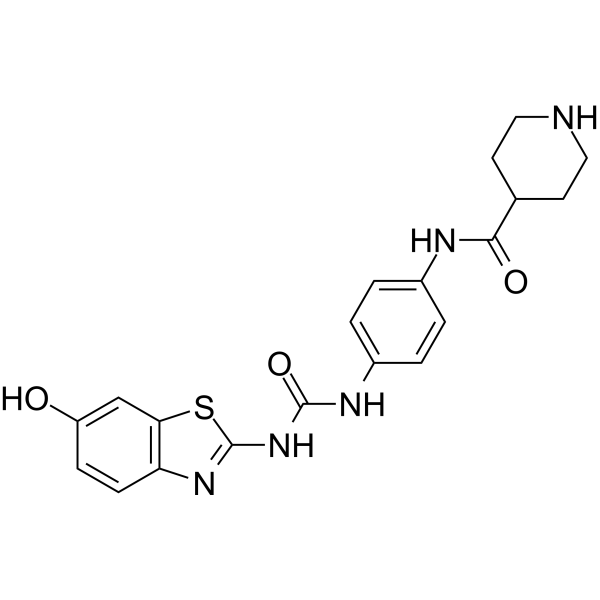
-
- HY-139300
-
|
HMPL-813
|
EGFR
|
Cancer
|
|
Epitinib is an orally active and selective epidermal growth factor receptor tyrosine kinase inhibitor (EGFR-TKI) designed for optimal brain penetration. Epitinib can be used for the research of cancer . Epitinib is a click chemistry reagent, it contains an Alkyne group and can undergo copper-catalyzed azide-alkyne cycloaddition (CuAAc) with molecules containing Azide groups.
|
-

-
- HY-116016
-
|
L-DOPA ethyl ester; Levodopa ethyl ester
|
Dopamine Receptor
Drug Metabolite
|
Neurological Disease
|
|
Etilevodopa (L-Dopa ethyl ester), an ethyl-ester proagent of Levodopa, is rapidly hydrolyzed to Levodopa and ethanol by nonspecific esterases in the gastrointestinal tract. Etilevodopa is used for the treatment of Parkinson disease (PD). Levodopa is the direct precursor of dopamine and is a suitable proagent as it facilitates CNS penetration and delivers dopamine .
|
-

-
- HY-116016A
-
|
L-DOPA ethyl ester hydrochloride; Levodopa ethyl ester hydrochloride
|
Dopamine Receptor
Drug Metabolite
|
Neurological Disease
|
|
Etilevodopa (L-Dopa ethyl ester) hydrochloride, an ethyl-ester proagent of Levodopa, is rapidly hydrolyzed to Levodopa and ethanol by nonspecific esterases in the gastrointestinal tract. Etilevodopa hydrochloride is used for the treatment of Parkinson disease (PD). Levodopa is the direct precursor of dopamine and is a suitable proagent as it facilitates CNS penetration and delivers dopamine .
|
-
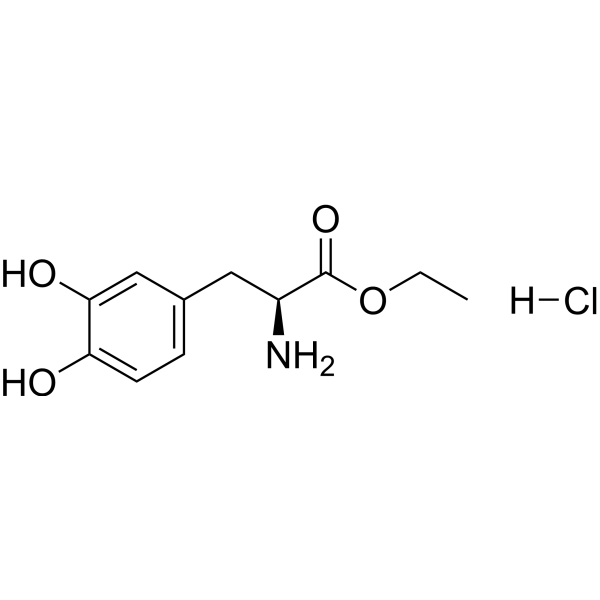
-
- HY-111406
-
|
DE-117
|
Prostaglandin Receptor
|
Inflammation/Immunology
|
|
Omidenepag isopropyl is a selective EP2 receptor agonist. Omidenepag isopropyl is converted to the active product Omidenepag during corneal penetration, and Omidenepag is a highly selective EP2 receptor agonist. Omidenepag isopropyl shows only weak affinity for EP1, EP2, and FP receptors. Omidenepag isopropyl is under development for the treatment of glaucoma as an intraocular pressure (IOP)-lowering agent.
|
-
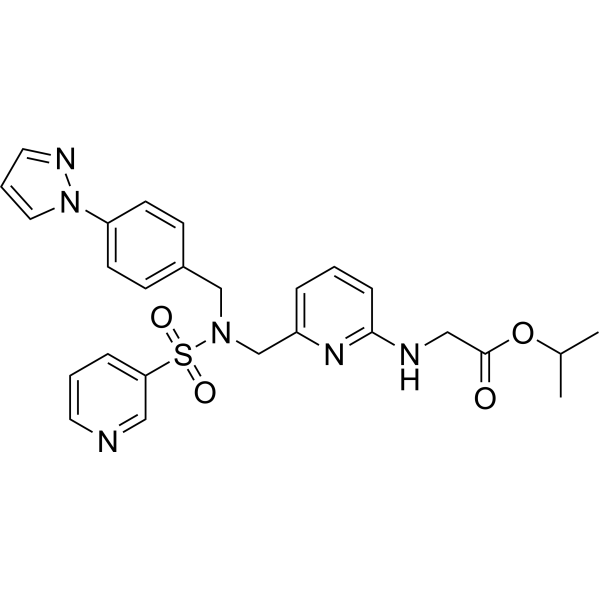
-
- HY-139300A
-
|
HMPL-813 succinate
|
EGFR
|
Cancer
|
|
Epitinib succinate is an orally active and selective epidermal growth factor receptor tyrosine kinase inhibitor (EGFR-TKI) designed for optimal brain penetration. Epitinib succinate can be used for the research of cancer . Epitinib (succinate) is a click chemistry reagent, it contains an Alkyne group and can undergo copper-catalyzed azide-alkyne cycloaddition (CuAAc) with molecules containing Azide groups.
|
-
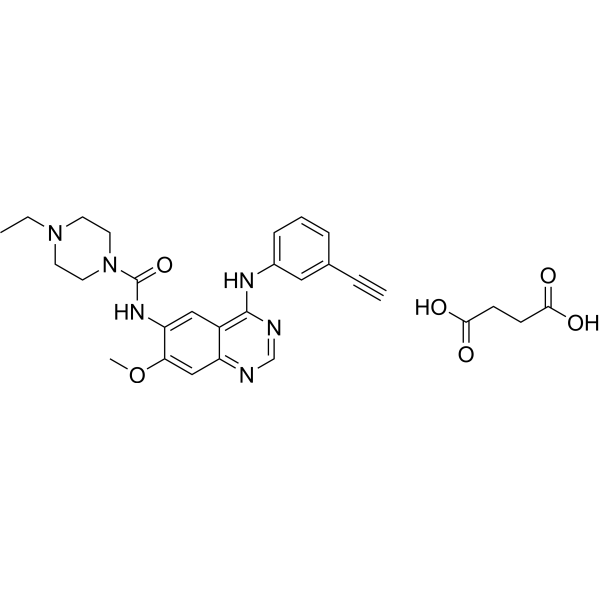
-
- HY-149065
-
|
|
α-synuclein
|
Neurological Disease
|
|
D-685, a prodrug of D-520, exhibits higher in vivo anti-Parkinsonian efficacy in a reserpinized Parkinson's disease (PD) animal model than the parent D-520. D-685 reduces accumulation of human α-synuclein (α-syn) protein. D-685 exhibits facile brain penetration .
|
-

-
- HY-120124
-
|
SUVN-G3031
|
Histamine Receptor
|
Neurological Disease
|
|
Samelisant (SUVN-G3031) is a potent and selective histamine H3 receptor (H3R) inverse agonist with good brain penetration and oral bioavailability. Samelisant has a similar binding affinity towards human (hH3R; Ki=8.7 nM) and rat (rH3R;Ki=9.8 nM) H3R indicating no inter-species differences. Samelisant can be used for the research of sleep-related disorders .
|
-
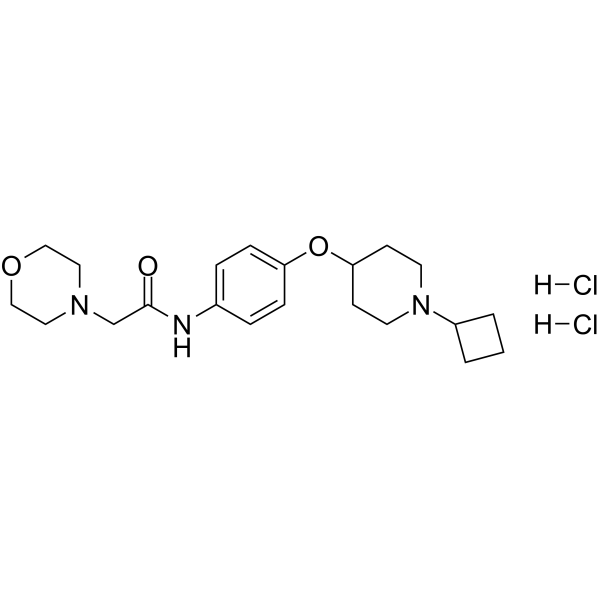
-
- HY-11044
-
|
|
Histamine Receptor
|
Neurological Disease
Inflammation/Immunology
Endocrinology
|
|
PF-03654746 Tosylate is a potent and selective histamine H3 receptor antagonist with high brain penetration. PF-03654746 Tosylate reduces allergen-induced nasal symptoms . PF-03654746 Tosylate has potential for treatment of human cognitive disorders, improves cognitive efficacy and disease-modifying effects in Alzheimer's disease (AD) .
|
-
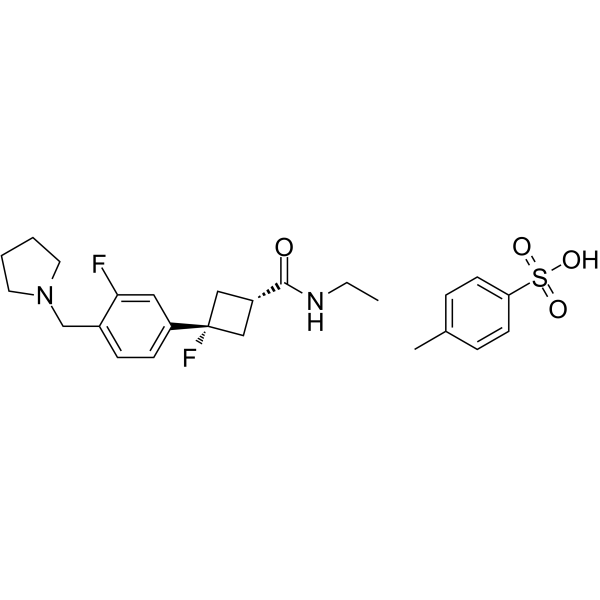
-
- HY-10096
-
|
|
GSK-3
|
Neurological Disease
|
|
TCS2002 (Compound 9b) is a highly selective, orally bioavailable and potent GSK-3β inhibitor with the IC50 of 35 nM. TCS2002 shows good pharmacokinetic profiles including favorable BBB penetration. TCS2002 can be used for the research of Alzheimer’s disease .
|
-

-
- HY-145313
-
|
|
Others
|
Neurological Disease
|
|
TTBK1-IN-2 (compound 29) is a potent Tau-Tubulin kinase (TTBK1) inhibitor with IC50s of 0.24 and 4.22 µM, respectively. TTBK1-IN-2 reveals good brain penetration in vivo and is able to reduce TDP-43 phosphorylation not only in cell cultures but also in the spinal cord of transgenic TDP-43 mice .
|
-
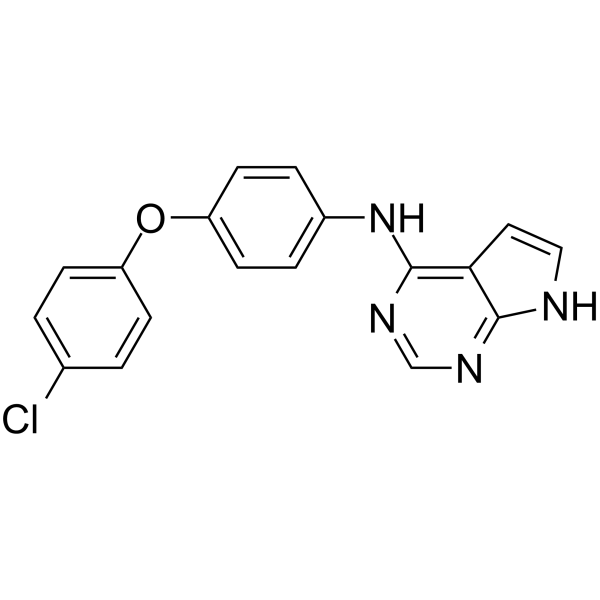
-
- HY-101855
-
|
Anle138b
|
Amyloid-β
|
Neurological Disease
|
|
Emrusolmin (Anle138b), an oligomeric aggregation inhibitor, blocks the formation of pathological aggregates of prion protein (PrPSc) and of α-synuclein (α-syn). Emrusolmin strongly inhibits oligomer accumulation, neuronal degeneration, and disease progression in vivo. Emrusolmin has low toxicity and an excellent oral bioavailability and blood-brain-barrier penetration. Emrusolmin blocks Aβ channels and rescues disease phenotypes in a mouse model for amyloid pathology .
|
-

-
- HY-155672
-
|
|
5-HT Receptor
|
Neurological Disease
|
|
JPC0323 is a dual 5-HT2C/5-HT2A receptor positive allosteric modulator. JPC0323 has on-target properties, acceptable plasma exposure and brain penetration. JPC0323 can be used for the research of neurological disease .
|
-
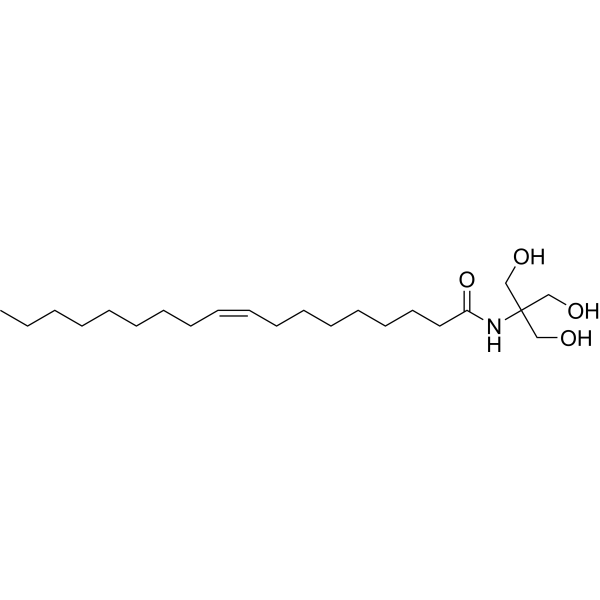
-
- HY-108460
-
|
|
TRP Channel
|
Neurological Disease
|
|
A-784168 is a potent and orally active inhibitor of vanilloid receptor type 1 (TRPV1). Vanilloid receptor type 1 (TRPV1) is a ligand-gated nonselective cation channel that is considered to be an important integrator of various pain stimuli such as endogenous lipids, capsaicin, heat, and low pH. A-784168 has good CNS penetration .
|
-
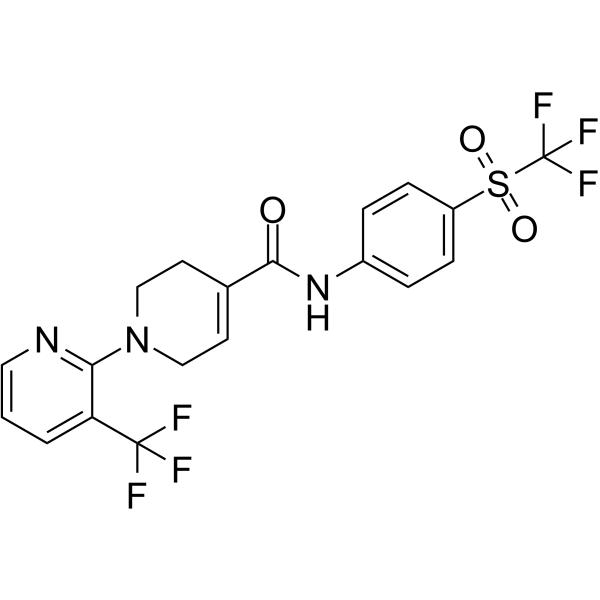
-
- HY-12844
-
|
|
Opioid Receptor
|
Neurological Disease
|
|
Ro 64-6198 is a potent, selective, nonpeptide, high-affinity, high cellular permeability and brain penetration N/OFQ receptor (NOP) agonist with an EC50 value of 25.6 nM. Ro 64-6198 is at least 100 times more selective for the NOP receptor over the classic opioid receptors. Ro 64-6198 can be used for stress and anxiety, addiction, neuropathic pain, cough, and anorexia .
|
-
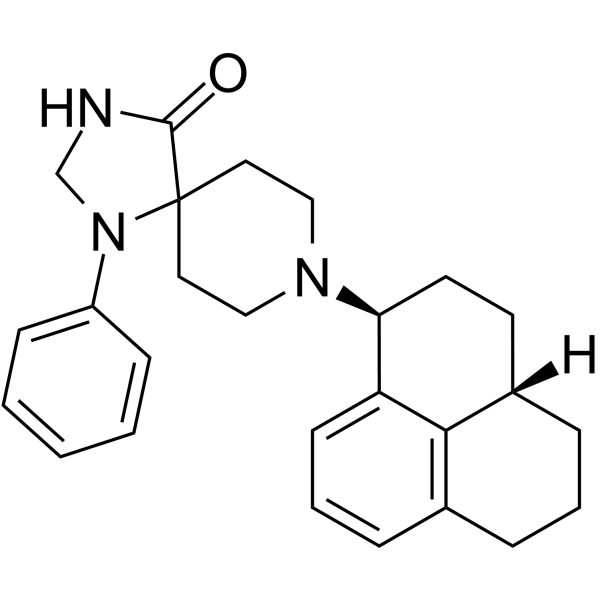
-
- HY-122608
-
|
SUVN-G3031 free base
|
Histamine Receptor
|
Neurological Disease
|
|
Samelisant (SUVN-G3031) free base is a potent and selective histamine H3 receptor (H3R) inverse agonist with good brain penetration and oral bioavailability. Samelisant free base has a similar binding affinity towards human (hH3R; Ki=8.7 nM) and rat (rH3R;Ki=9.8 nM) H3R indicating no inter-species differences. Samelisant free base can be used for the research of sleep-related disorders .
|
-
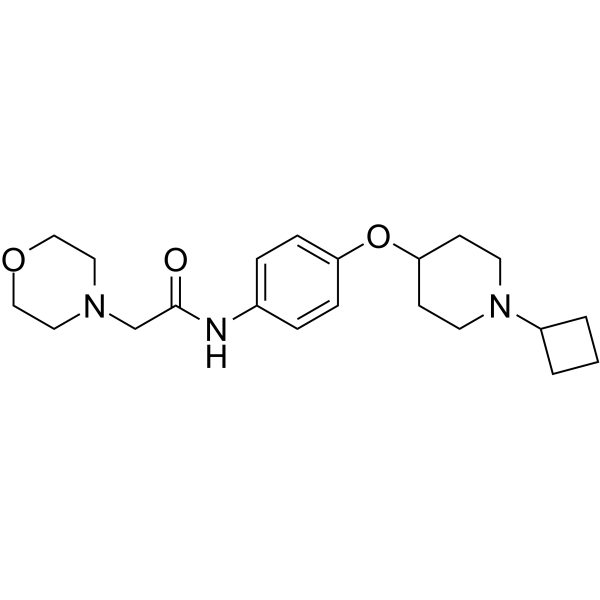
-
- HY-123410
-
|
|
Cannabinoid Receptor
|
Cancer
|
|
KM-233 is a classical cannabinoid with good blood brain barrier penetration. KM-233 possesses a selective affinity for the CB2 receptors relative to THC. KM-233 is effective at reducing U87 glioma tumor burden, and can be used for glioma research .
|
-

-
- HY-144389
-
|
|
Cholinesterase (ChE)
Amyloid-β
|
Neurological Disease
|
|
hAChE/Aβ1-42-IN-1 (Compound 16) is a potent inhibitor of hAChE and Aβ1-42 aggregation. hAChE/Aβ1-42-IN-1 shows acceptable relative safety upon hepG2 cell line and excellent BBB penetration with wide safety margin. hAChE/Aβ1-42-IN-1 has the potential for the research of Alzheimer disease (AD) .
|
-

-
- HY-144388
-
|
|
Cholinesterase (ChE)
Amyloid-β
|
Neurological Disease
|
|
ChE/Aβ1-42-IN-1 (compound 28) is a potent ChE and Aβ1-42 aggregation inhibitor with IC50s of 0.062, 0.767 and 1.227 µM for AChE, BuChE and Aβ1-42 aggregation, respectively. ChE/β1-42-IN-1 shows excellent BBB penetration. ChE/Aβ1-42-IN-1 is a potent multi-targeted anti-Alzheimer's agent .
|
-
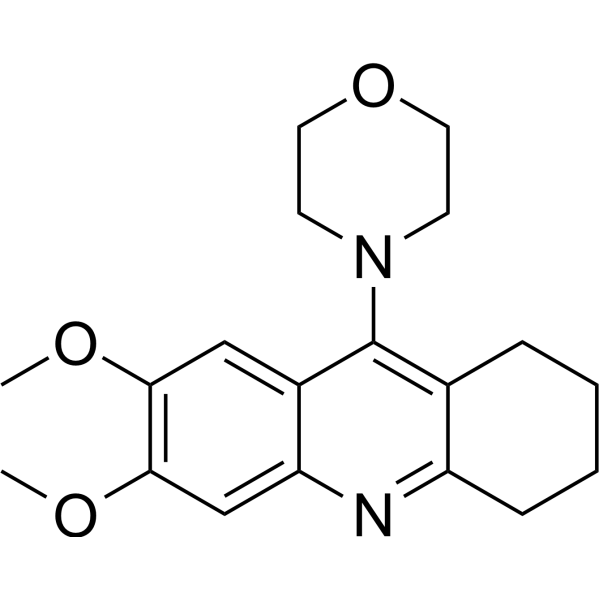
-
- HY-148825
-
-
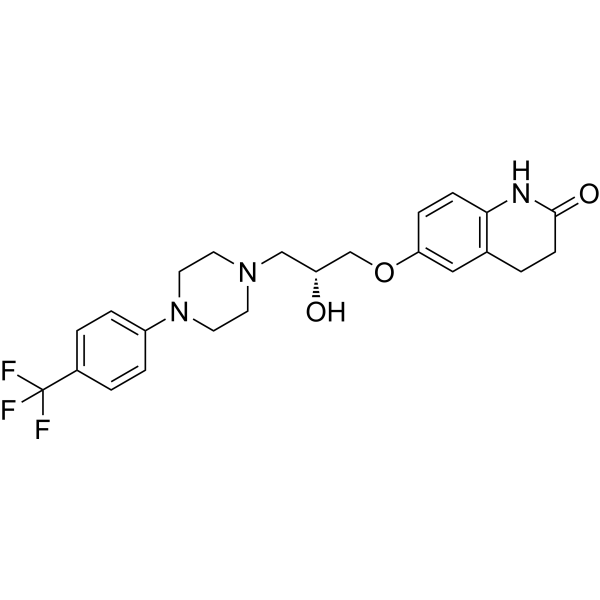
-
- HY-110206
-
|
|
Cannabinoid Receptor
|
Metabolic Disease
|
|
AM6545 is a peripherally active, cannabinoid receptor antagonist with limited brain penetration. AM6545 binds to CB1 and CB2 receptors with Kis of 1.7 nM and 523 nM, respectively. AM6545 is a neutral antagonist. AM6545 can be used for the research of obesity and its complications .
|
-
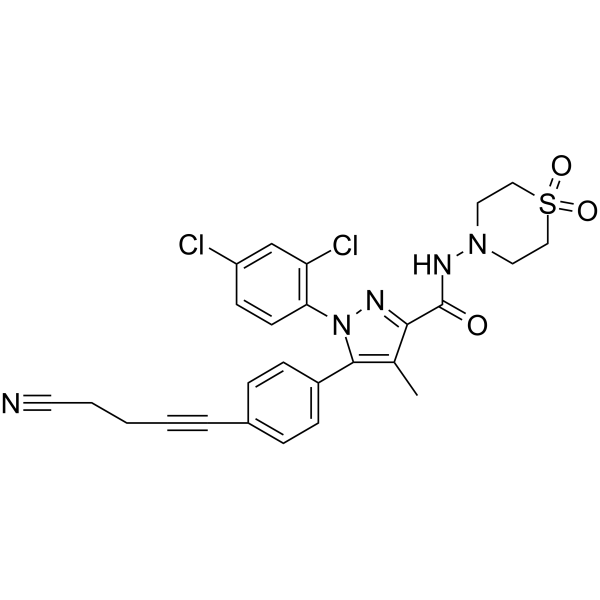
-
- HY-14205
-
|
|
Monoamine Oxidase
|
Neurological Disease
|
|
NW-1772 (methanesulfonate) (22b) is a potent and selective monoamine oxidase (MAO) B inhibitor. NW-1772 (methanesulfonate) is the equivalent of HY-111156 NW-1772. NW-1772 has some advantages, such as rapid blood-brain barrier penetration, short-acting and reversible inhibitory activity, slight inhibition of selected cytochrome P450s, and low in vitro toxicity. NW-1772 can be used for the research of neurodegenerative diseases .
|
-

-
- HY-147999
-
|
|
Bacterial
Fungal
Cytochrome P450
|
Infection
|
|
GlcN-6-P Synthase-IN-1 (Compound 4d) is a Glucosamine-6-phosphate (GlcN-6-P) synthase inhibitor with an IC50 of 3.47 μM. GlcN-6-P Synthase-IN-1 exhibits significant antimicrobial activity. GlcN-6-P Synthase-IN-1 has good penetration in the CNS and is able to inhibit the cytochrome P450, CYP3A4 isoform .
|
-

-
- HY-120184
-
|
AZ13713945
|
mAChR
|
Neurological Disease
|
|
VU0467485 (AZ13713945) is a potent, selective, and orally bioavailable muscarinic acetylcholine receptor 4 (M4) positive allosteric modulator (PAM). VU0467485 (AZ13713945) potentiates activity of ACh at M4 with EC50s of 26.6 nM and 78.8 nM at rat and human M4 receptors, respectively. VU0467485 (AZ13713945) shows selectivity for M4 over human and rat M1/2/3/5. VU0467485 (AZ13713945) displays moderate to high CNS penetration. VU0467485 (AZ13713945) has antipsychotic-like activity .
|
-

-
- HY-115727
-
-
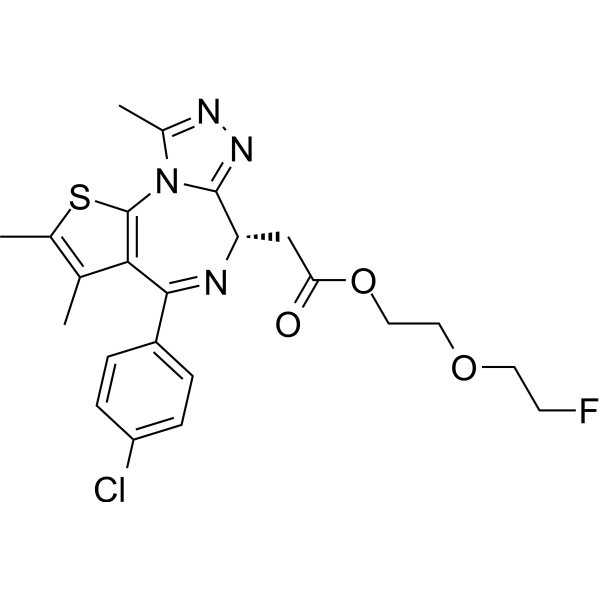
-
- HY-156717
-
-

-
- HY-147151
-
|
|
Others
|
Others
|
|
AMCPy is a potent electron paramagnetic resonance (EPR) brain imaging agent, possessing excellent lipophilicity for blood−brain barrier (BBB) penetration .
|
-
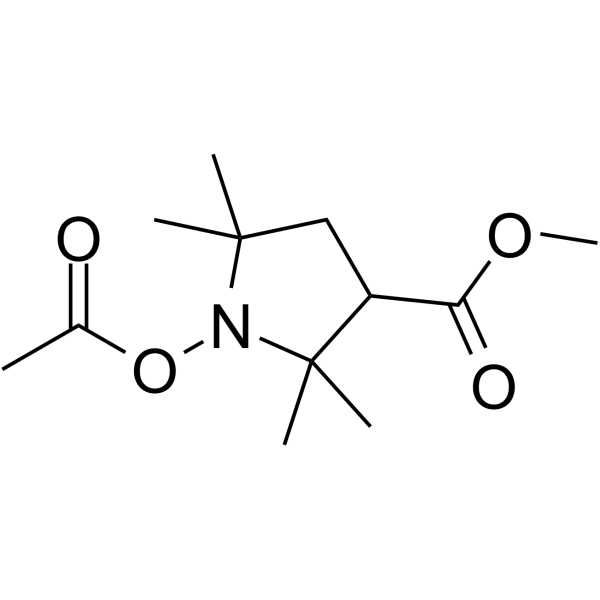
-
- HY-117776
-
|
|
ICMT
|
Cancer
|
|
CAY10677 (compound 15) is a potent ICMT inhibitor that inhibits cancer cell proliferation. CAY10677 has good PAMPA penetration .
|
-
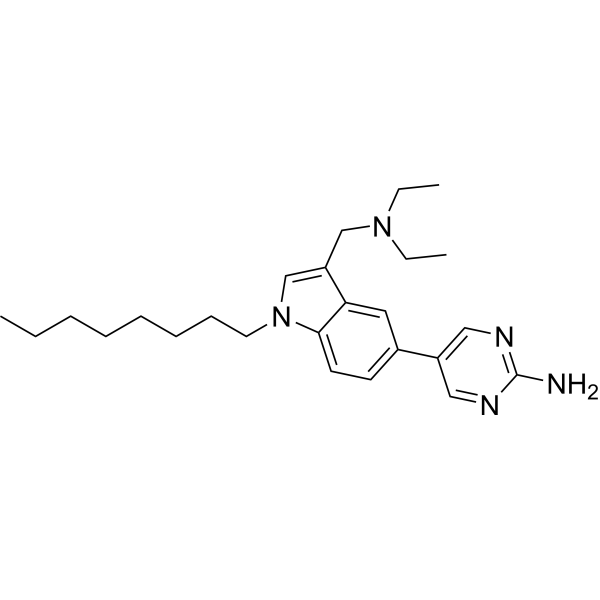
-
- HY-130121
-
|
|
Others
|
Neurological Disease
|
|
MK-8719 is a highly potent and selective O-GlcNAcase (OGA) inhibitor (Ki=7.9 nM for hOGA) with excellent CNS penetration .
|
-
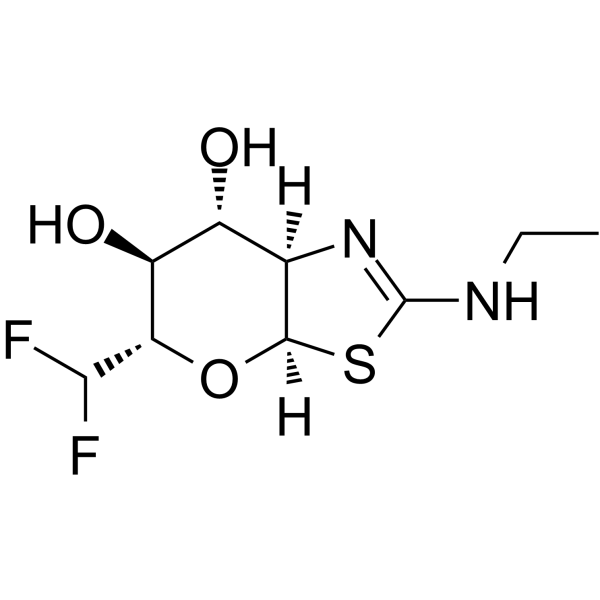
-
- HY-137207
-
MK-28
3 Publications Verification
|
PERK
|
Neurological Disease
|
|
MK-28 is a potent and selective PERK activator. MK-28 exhibits remarkable pharmacokinetic properties and high BBB penetration in mice .
|
-
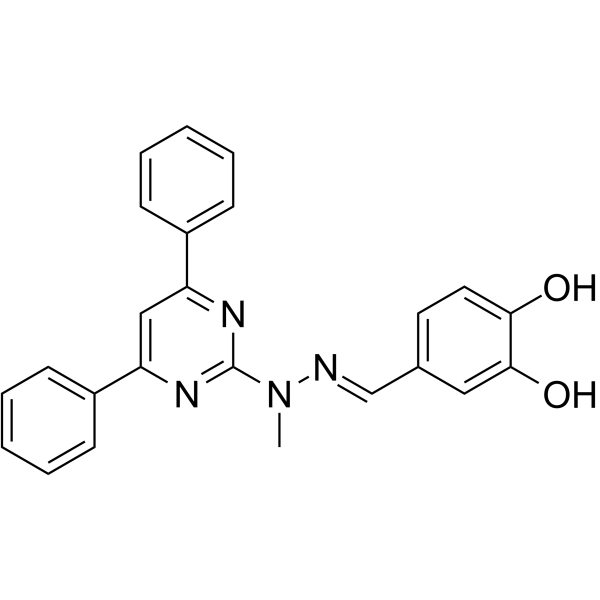
-
- HY-13011S
-
|
CH5424802-d8; RO5424802-d8; AF802-d8
|
Anaplastic lymphoma kinase (ALK)
|
Cancer
|
|
Alectinib-d8 is the deuterium labeled Alectinib. Alectinib (CH5424802) is a potent, selective, and orally available ALK inhibitor with an IC50 of 1.9 nM and a Kd value of 2.4 nM (in an ATP-competitive manner), and also inhibits ALK F1174L and ALK R1275Q with IC50s of 1 nM and 3.5 nM, respectively[1]. Alectinib demonstrates effective central nervous system (CNS) penetration[2].
|
-

-
- HY-13011S1
-
|
CH5424802-d6; RO5424802-d6; AF802-d6
|
Isotope-Labeled Compounds
Anaplastic lymphoma kinase (ALK)
|
Cancer
|
|
Alectinib-d6 is deuterium labeled Alectinib. Alectinib (CH5424802) is a potent, selective, and orally available ALK inhibitor with an IC50 of 1.9 nM and a Kd value of 2.4 nM (in an ATP-competitive manner), and also inhibits ALK F1174L and ALK R1275Q with IC50s of 1 nM and 3.5 nM, respectively[1]. Alectinib demonstrates effective central nervous system (CNS) penetration[2].
|
-

-
- HY-150972
-
|
|
Fungal
|
Infection
|
|
P163-0892 is a potent and selective antifungal agent against Cryptococcus species. P163-0892 is predicted to show medium BBB penetration .
|
-
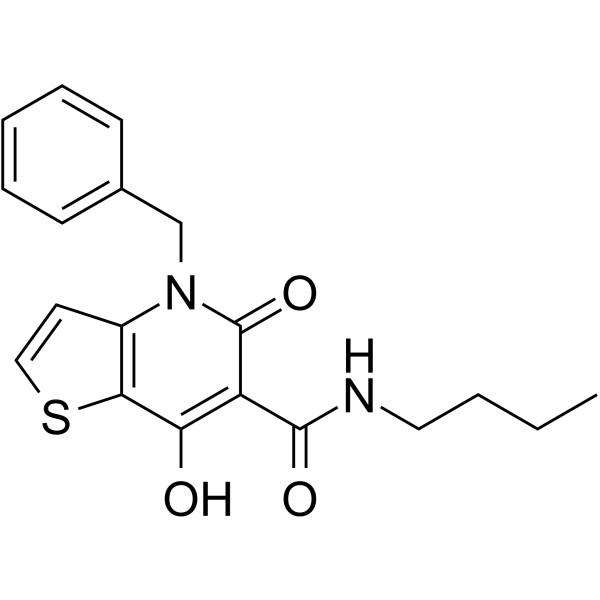
-
- HY-108463
-
|
|
TRP Channel
|
Inflammation/Immunology
|
|
A-967079 is a selective TRPA1 receptor antagonist with IC50s of 67 nM and 289 nM at human and rat TRPA1 receptors, respectively, and has good penetration into the CNS.
|
-
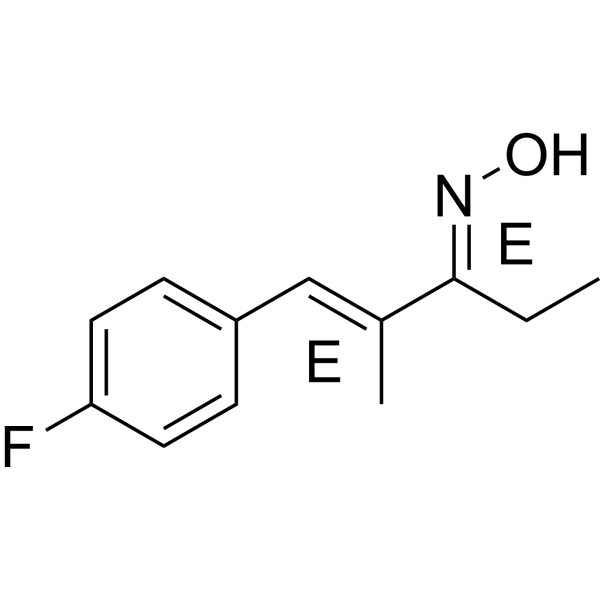
-
- HY-W105835
-
|
Trimagnesium dicitrate
|
Toll-like Receptor (TLR)
|
Neurological Disease
|
|
Magnesium citrate is a magnesium salt form that provides efficient penetration into brain and muscle tissue. Magnesium citrate increases pain threshold and reduces TLR4 concentration in the brain. Orally active .
|
-

-
- HY-101349A
-
|
|
Dopamine Receptor
|
Neurological Disease
|
|
L 741742 hydrochloride is an orally active and selective antagonist of hD4 receptors. L 741742 hydrochloride has a good brain penetration. L 741742 hydrochloride can be used in study nervous system disorders, particularly schizophrenia .
|
-
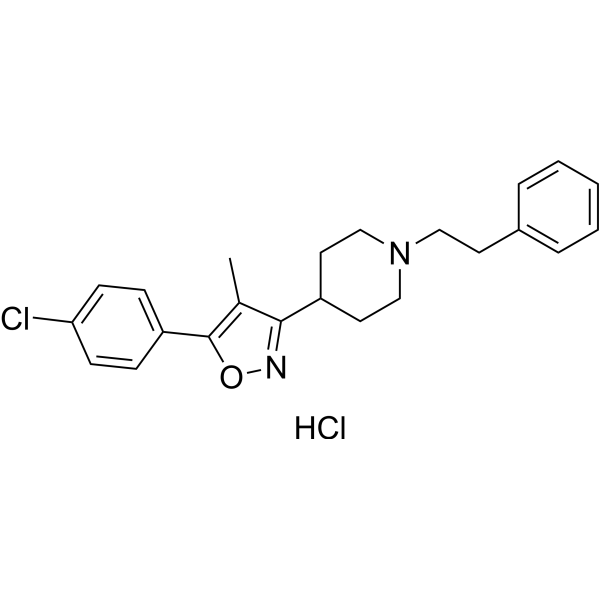
-
- HY-119649
-
|
IKI220
|
Parasite
|
Infection
|
|
Flonicamid (IKI220) is a novel systemic insecticide with selective activity against hemipterous pests. The main insecticidal mechanism of flonicamid is starvation based on the inhibition of stylet penetration to plant tissues .
|
-

-
- HY-12599
-
-
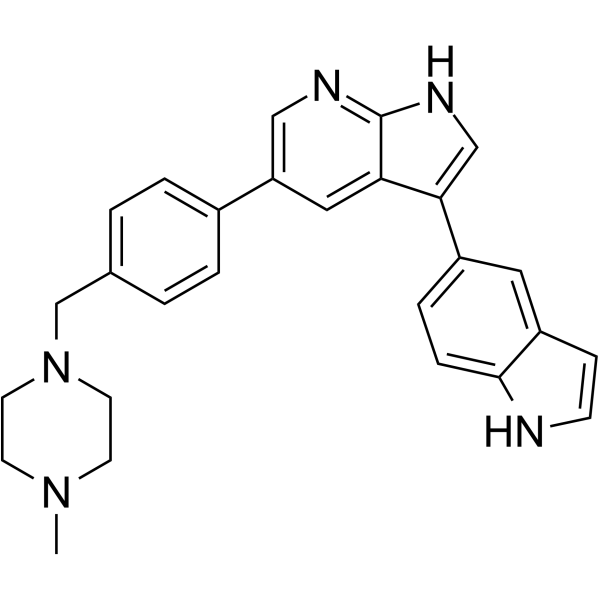
-
- HY-16617
-
|
VU0424238
|
mGluR
|
Neurological Disease
|
|
Auglurant (VU0424238) is a novel and selective mGlu5 antagonist with an IC50 value of 11 nM (rat) and an IC50 value of 14 nM (human). Auglurant (VU0424238) has an acceptable CNS penetration .
|
-
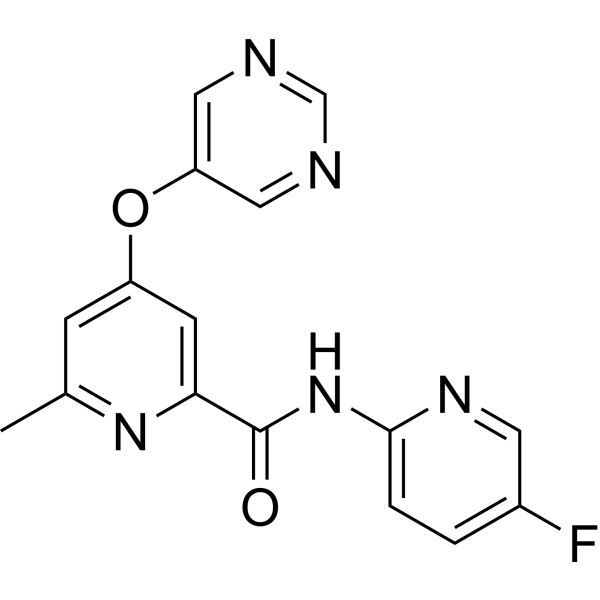
-
- HY-111258
-
-

- HY-147821
-
|
|
Cannabinoid Receptor
|
Metabolic Disease
|
|
CB1-IN-2 (Compound 4g) is a selective CB1 inhibitor with an IC50 of 0.644 μM. CB1-IN-2 can penetrates BBB and might cause CNS side effect similar with Rimonabant .
|
-
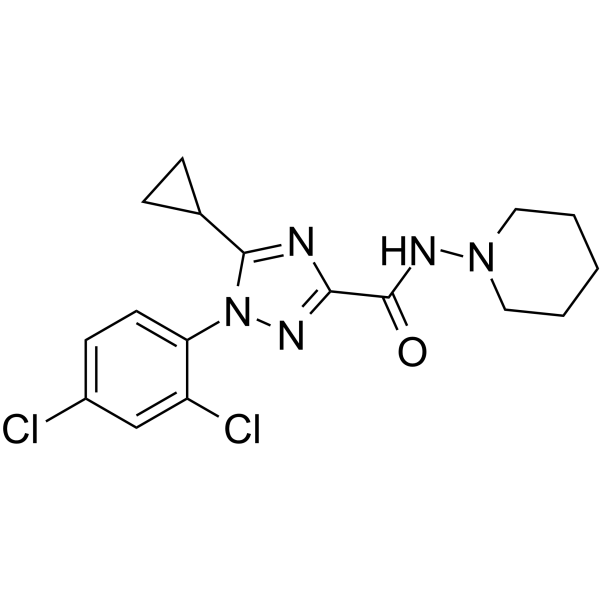
- HY-101789
-
|
|
Sodium Channel
|
Neurological Disease
|
|
Nav1.7-IN-3 is a selective, orally bioavailable voltage-gated sodium channel Nav1.7 inhibitor with an IC50 of 8 nM. Pain relief. Limited CNS penetration .
|
-
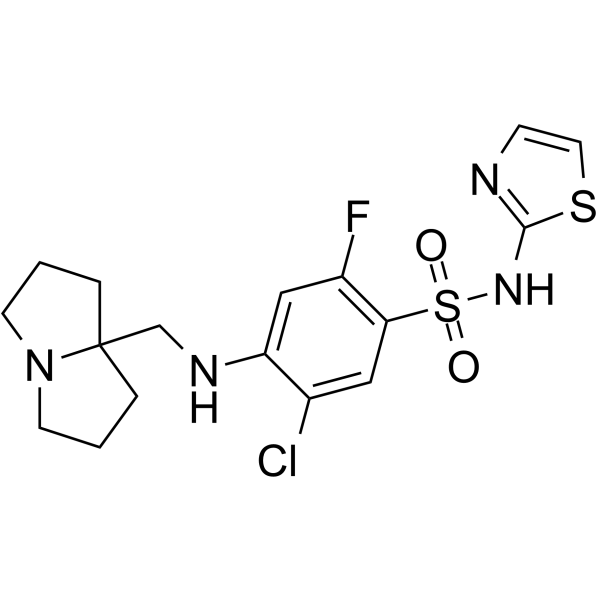
- HY-105860
-
|
BGG 492
|
iGluR
|
Neurological Disease
|
|
Selurampanel (BGG 492) is an orally active and competitive AMPA receptor antagonist with an IC50 of 190 nM. Selurampanel has reasonable blood-brain barrier penetration. Selurampanel can be used for epilepsy research .
|
-
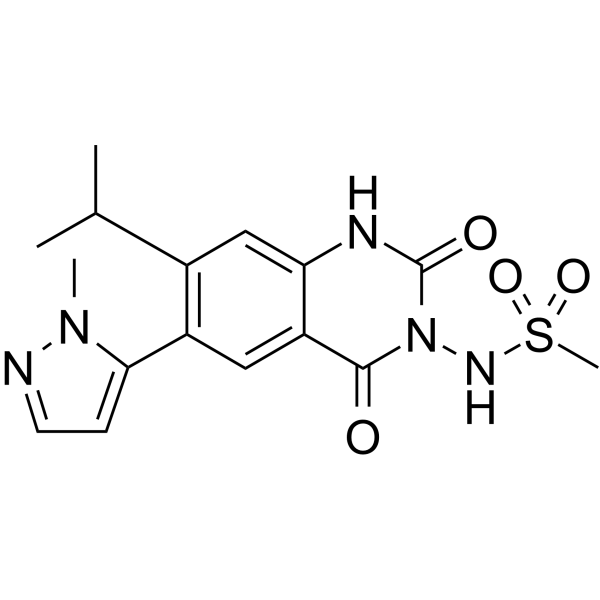
- HY-101076
-
|
|
|
|
|
L-690488 is a proagent of L-690330 and is a selective inositol monophosphatase (IMPase) inhibitor. L-690488 has more effective cell penetration than L-690330 .
|
-
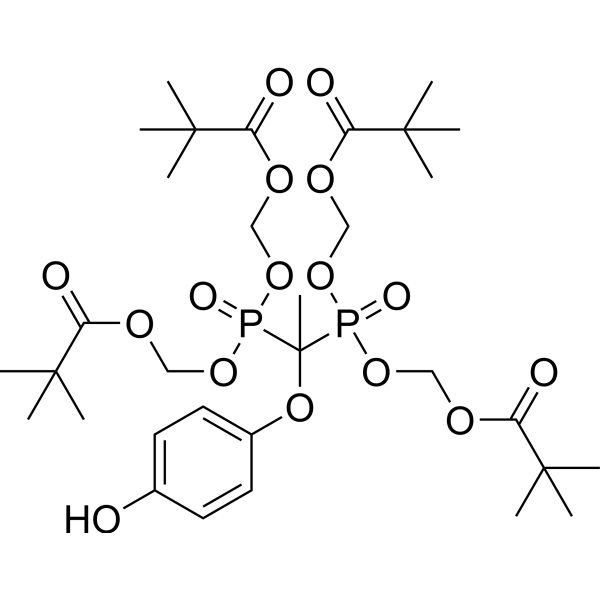
- HY-D1392
-
|
Ag2Te
|
Fluorescent Dye
|
Others
|
|
Ag2Te QDs (Ag2Te) is an effective biological probe in the second near-infrared window (NIR-II) that can be used in bioimaging with high tissue penetration depth and high spatiotemporal resolution .
|
-
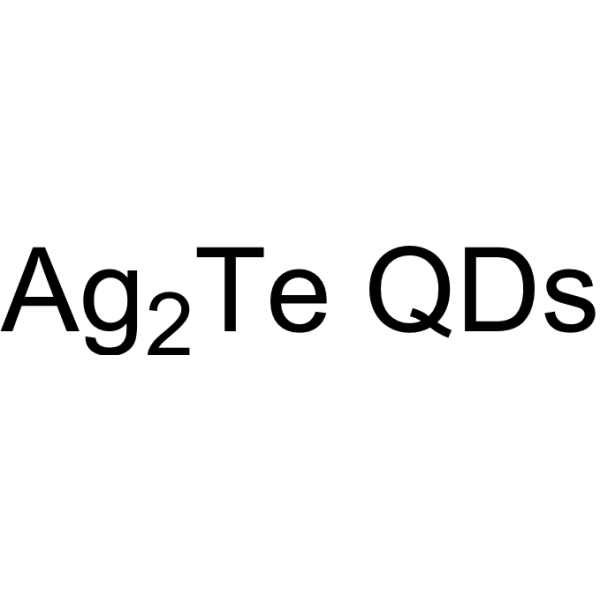
- HY-141866
-
|
|
Ceramidase
|
Neurological Disease
|
|
Acid Ceramidase-IN-1 is a potent and oral bioavailable acid ceramidase (AC, ASAH-1) inhibitor (hAC IC50=0.166 μM). Acid Ceramidase-IN-1 has excellent brain penetration in mice .
|
-
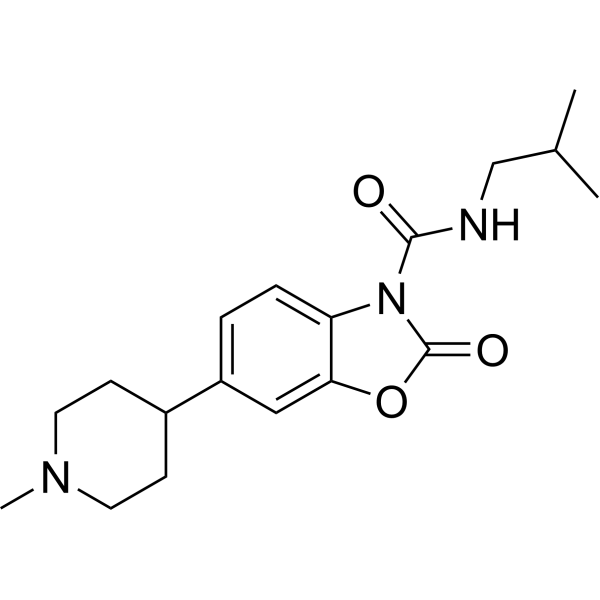
- HY-N12614
-
|
|
Phosphatase
|
Metabolic Disease
|
|
Diorcinol is a potent SHP1 inhibitor with an IC50 value of 0.96 μM. Diorcinol can be isolated from Aspergillus sydowii. Diorcinol has good blood-brain barrier penetration and can be used for diabetes research .
|
-

- HY-129920
-
|
PGE2 methyl ester
|
Others
|
Metabolic Disease
|
|
Prostaglandin E2 methyl ester (PGE2 methyl ester) is an lipophilic derivative analog of PGE2 (HY-101952). Prostaglandin E2 methyl ester has more central penetration ability than PGE2 .
|
-
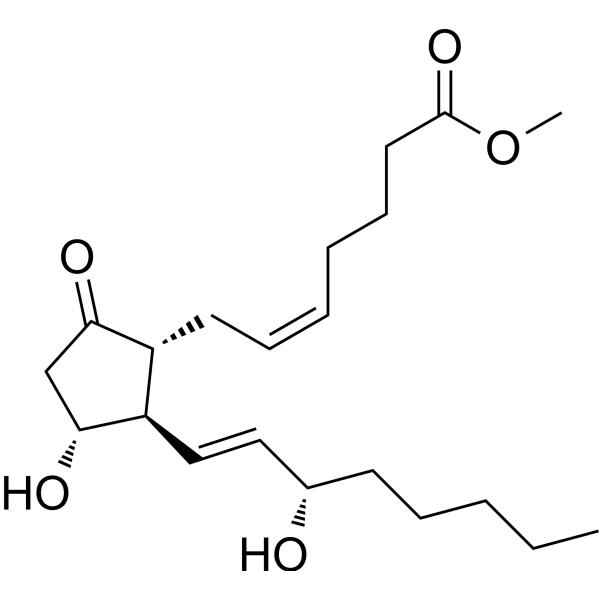
- HY-101281
-
|
|
|
|
|
VU 6008667 is a selective negative allosteric modulator of M5 NAM with IC50s of 1.2 μM and 1.6 μM for human M5 and rat M5, respectively. High CNS penetration .
|
-
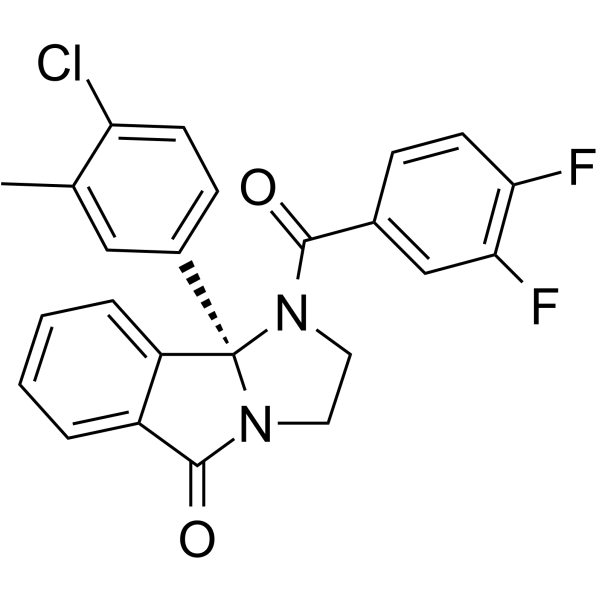
- HY-A0147
-
|
OPC-17116; dl-Grepafloxacin
|
|
|
|
Grepafloxacin (OPC-17116) is an oral actively fluoroquinolone antibiotic with potent activity against community-acquired respiratory pathogens including Streptococcus pneumonia. Grepafloxacin has high tissue penetration and a promising pharmacodynamic profile .
|
-
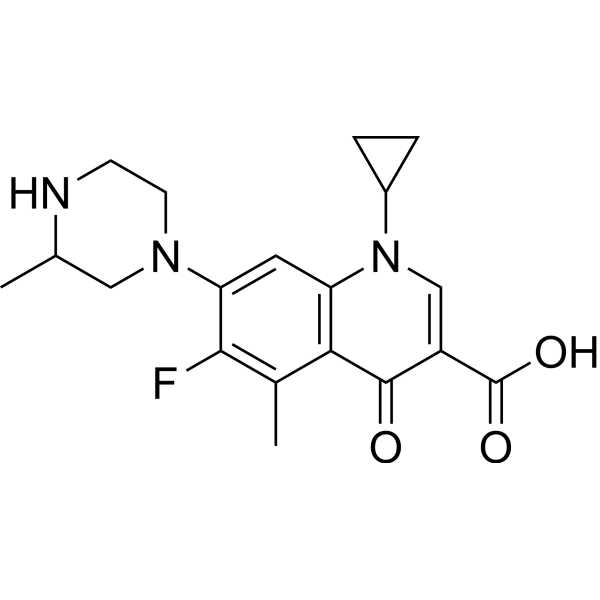
- HY-P99565
-
|
ARENEGYR; NGR-TNF; NGR-hTNF
|
TNF Receptor
|
Cancer
|
|
Tengonermin (ARENEGYR) is a vascular-targeting agent consisting of the human Tumour Necrosis Factor-α (TNF-α) conjugated with the CNGRCG peptide. Tengonermin increases penetration of intratumoral chemotherapy and T-cell infiltration by modifying the tumour microenvironment .
|
-

- HY-160410
-
|
|
Others
|
Neurological Disease
Inflammation/Immunology
|
|
Ceramide 3B is a ceramide 3 lipid class with aggregation behavior. Ceramide 3B has a variety of physiological functions and can serve as a penetration enhancer and auxiliary emulsifier, playing an important role in barrier function stability .
|
-
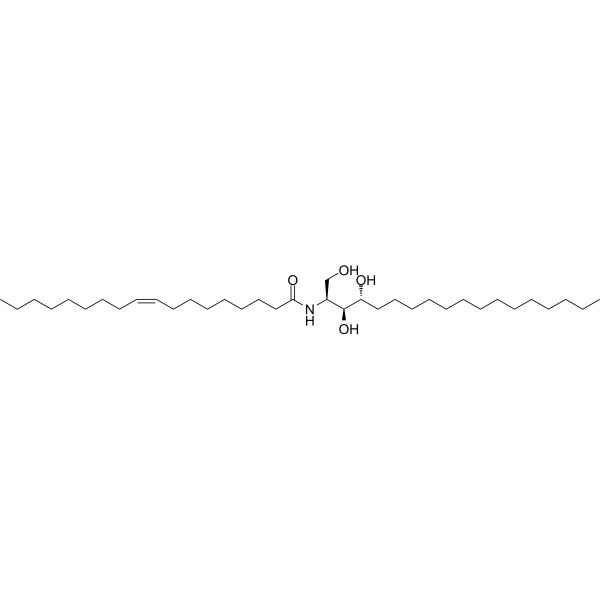
- HY-P0122
-
|
c(CRGDKGPDC)
|
|
|
|
iRGD peptide is a 9-amino acid cyclic peptide, triggers tissue penetration of agents by first binding to αv-integrins, then proteolytically cleaved in the tumor to produce CRGDK/R to interact with neuropilin-1, and has tumor-targeting and tumor-penetrating properties.
|
-
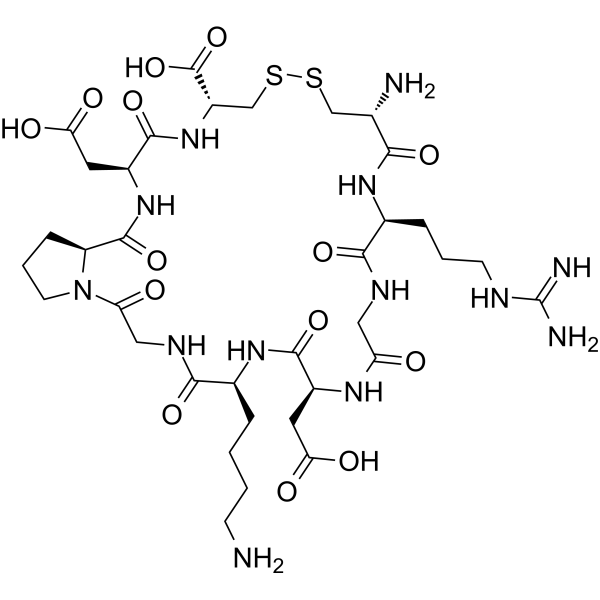
- HY-152632
-
|
|
Cholinesterase (ChE)
|
Neurological Disease
|
|
BuChE-IN-7 is a highly selective inhibitor of hBuChe and eqBuChE with IC50 values of 40 nM, 80 nM respectively. BuChE-IN-7 can promote cognitive with blood-brain penetration and improves situational and phobic memory, showing preference for new things .
|
-

- HY-112809
-
|
|
Syk
Src
LRRK2
GSK-3
JAK
VEGFR
Aurora Kinase
|
Inflammation/Immunology
|
|
GSK2646264 (Compound 44) is a potent and selective spleen tyrosine kinase (SYK) inhibitor with a pIC50 of 7.1. GSK2646264 also inhibits other kinases with pIC50 values of 5.4, 5.4, 5.3, 5, 4.5, <4.6 and <4.3 against LCK, LRRK2, GSK3β, JAK2, VEGFR2, Aurora B and Aurora A, respectively. GSK2646264 is penetrable into the epidermis and dermis of the skin .
|
-

- HY-B0250A
-
|
BCH-189 salicylate
|
HIV
Reverse Transcriptase
HBV
|
Infection
|
|
Lamivudine (BCH-189) salicylate is an orally active nucleoside reverse transcriptase inhibitor (NRTI). Lamivudine salicylate can inhibit HIV reverse transcriptase 1/2 and also the reverse transcriptase of hepatitis B virus. Lamivudine salicylate can penetrate the CNS .
|
-

- HY-17595
-
|
|
Parasite
Apoptosis
Microtubule/Tubulin
|
Infection
Cancer
|
|
Mebendazole is a highly effective, broad-spectrum antihelmintic against nematode infestations. Mebendazole also exhibits inhibitory effect against glioblastoma multiforme (GBM), inhibits Hedgehog pathway and tubulin polymerization. Mebendazole is orally active and can cross CNS penetration .
|
-
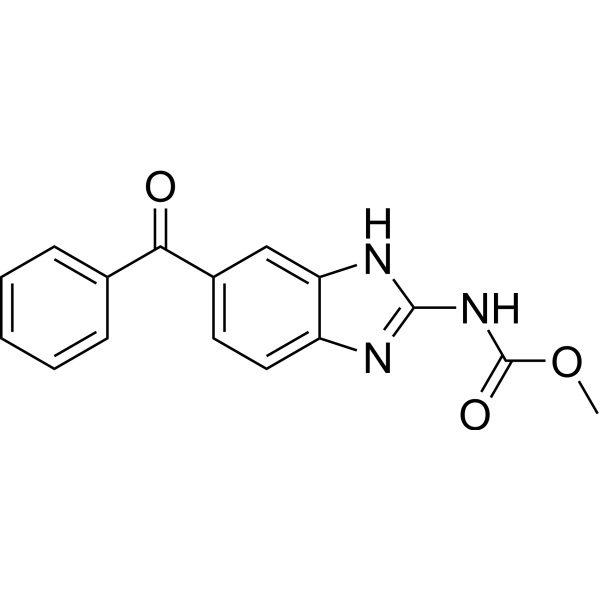
- HY-D1393
-
|
Pb:Ag2Se
|
Fluorescent Dye
|
Others
|
|
Pb:Ag2Se QDs (Pb:Ag2Se) is an effective biological probe in the second near-infrared window (NIR-II) that can be used in bioimaging with high tissue penetration depth and high spatiotemporal resolution .
|
-
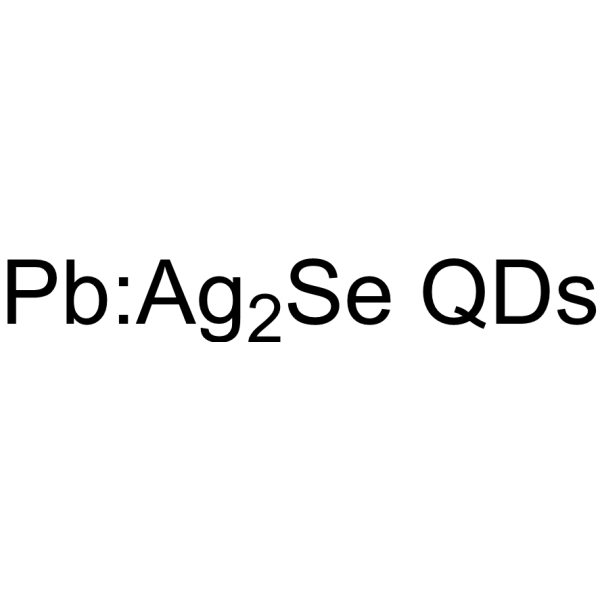
- HY-100238
-
|
|
|
|
|
Antihistamine-1 is a H1-antihistamine (Ki=6.9 nM) with acceptable blood-brain barrier penetration and also an inhibitor of CYP2D6 and hERG channel with IC50s of 5.4 and 0.8 μM, respectively.
|
-
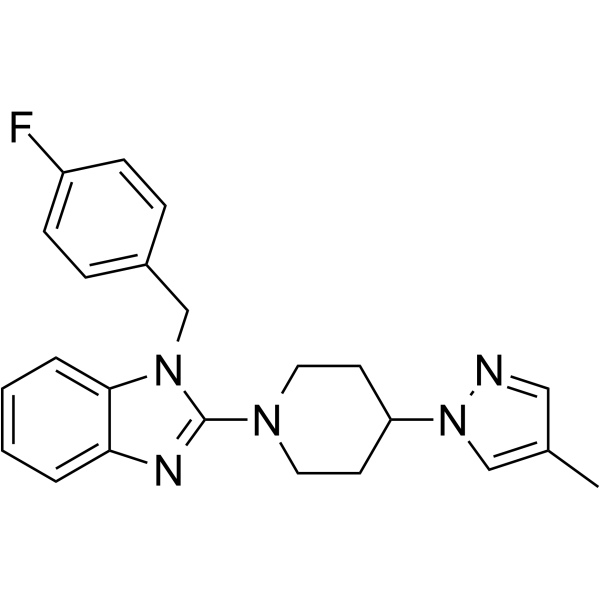
- HY-158003
-
|
|
Bacterial
|
Infection
|
|
COE-PNH2 exhibits antibacterial activity against Mycobacterium abscessus (Mab) with MIC90 of 26 μM. COE-PNH2 affects the integrity of the bacterial envelope and mycomembrane. COE-PNH2 reveals intracelluar penetration without mitochondrial toxicity .
|
-
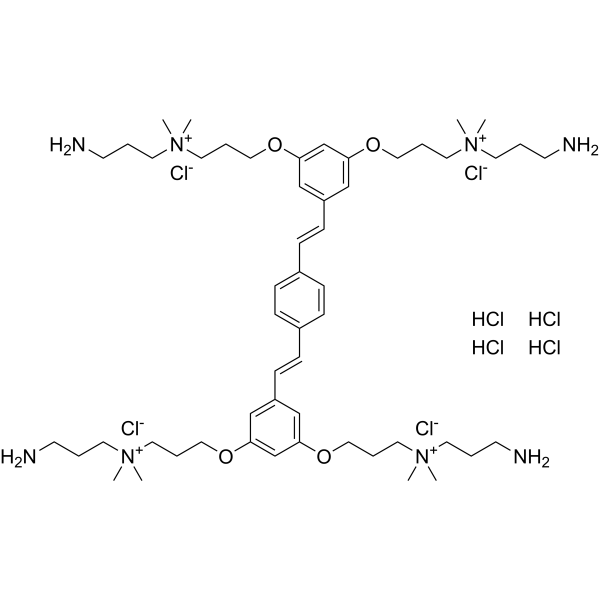
- HY-107666
-
-
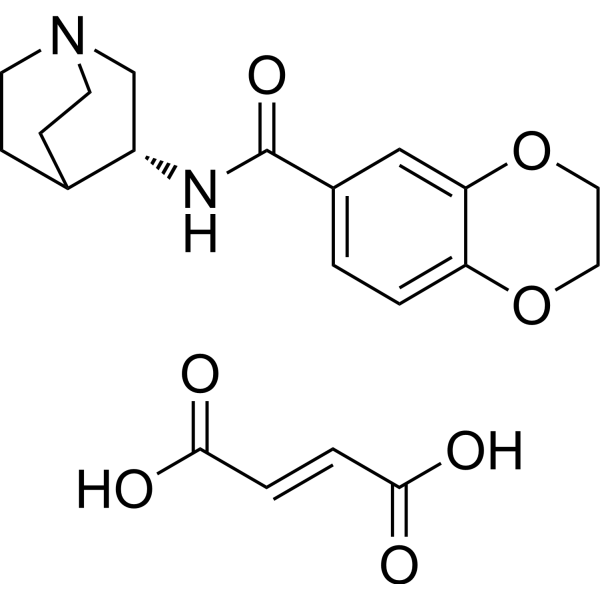
- HY-161380
-
|
|
Fungal
|
Infection
|
|
Antifungal agent 96 (Compound WZ-2) is an antifungal agent with good blood-brain barrier permeability and brain penetration. Antifungal agent 96 inhibits the growth of C. neoformans H99 and C. albicans 0304103 with MIC values of 0.016 and 32 μg/mL, respectively .
|
-

- HY-161029
-
|
|
Cholinesterase (ChE)
|
Neurological Disease
|
|
T14-A24 is an orally active, reversible, competitive, and selective AChE inhibitor (Ki=22 nM, IC50=6 nM). T14-A24 has benign BBB penetration, remarkable neuroprotective effect, and safe toxicological profile .
|
-
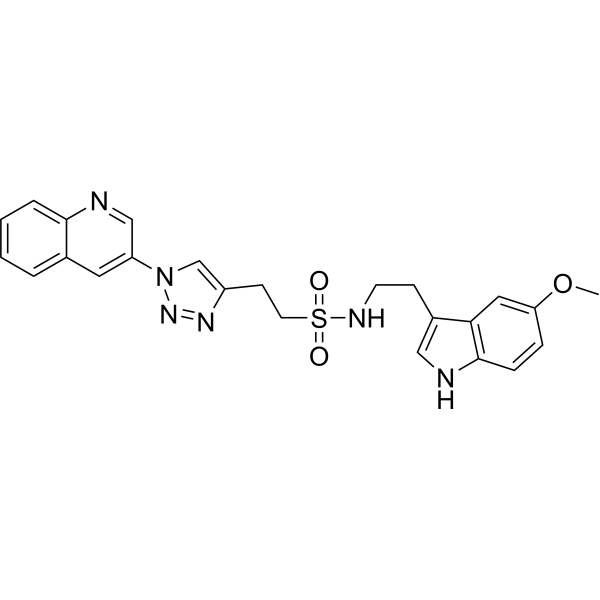
- HY-163131
-
|
|
Glucosylceramide Synthase (GCS)
|
Neurological Disease
|
|
Glucosylceramide synthase-IN-4 (compound 12) is a potent glucosylceramide synthase (GCS) inhibitor, with an IC50 of 6.8 nM. Glucosylceramide synthase-IN-4 shows excellent PK properties and stability in human hepatocytes. Glucosylceramide synthase-IN-4 has good CNS penetration and acceptable PXR selectivity .
|
-
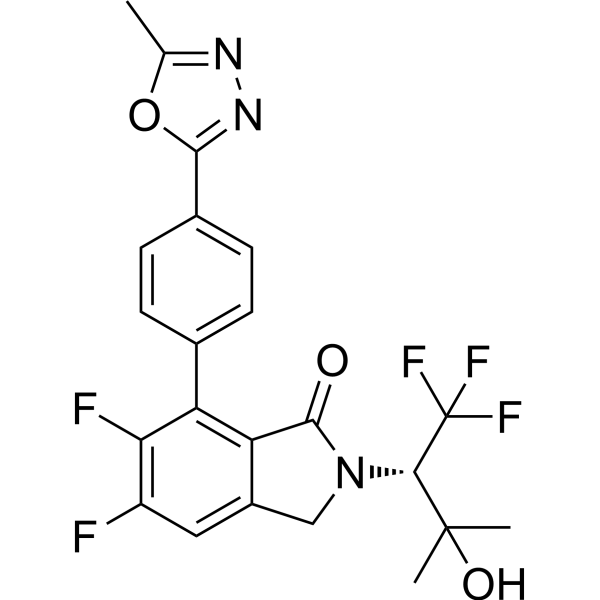
- HY-146101
-
|
|
iGluR
|
Neurological Disease
|
|
NMDA receptor antagonist 5 (Compound 10e) is a potent, brain permeable and non-toxic NMDA receptor antagonist. NMDA receptor antagonist 5 can be used for neurological disorder research .
|
-
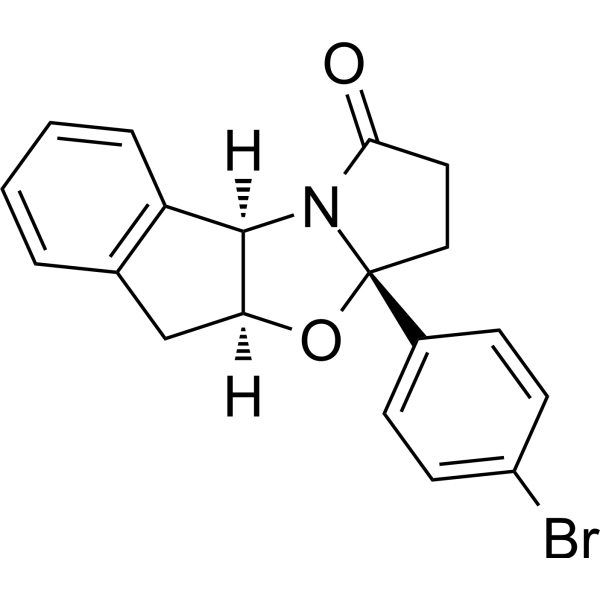
- HY-108625
-
SHA 68
1 Publications Verification
|
Neuropeptide Y Receptor
|
Neurological Disease
|
|
SHA 68 is a potent and selective non-peptide neuropeptide S receptor (NPSR) antagonist with IC50s of 22.0 and 23.8 nM for NPSR Asn 107 and NPSR Ile 107, respectively. SHA 68 has limited the blood-brain barrier (BBB) penetration and the activity in neuralgia .
|
-
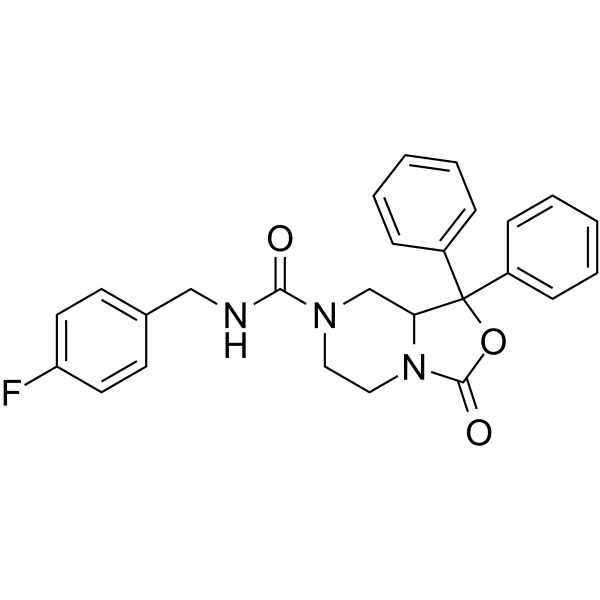
- HY-128865
-
|
|
Opioid Receptor
|
Neurological Disease
|
|
BPR1M97 is a dual-acting mu opioid receptor (MOP) and nociceptin-orphanin FQ peptide (NOP) receptor agonist with Ki values of 1.8 and 4.2 nM, respectively. BPR1M97 shows high potency and blood-brain barrier penetration, and produces potent antinociceptive effects .
|
-
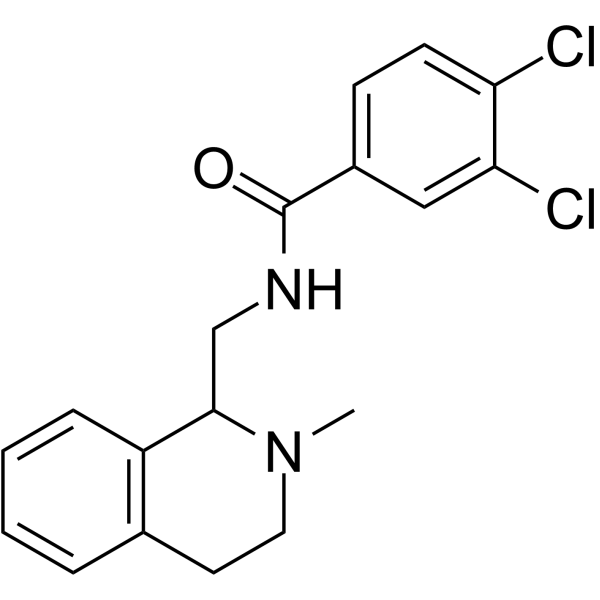
- HY-127106
-
|
|
Potassium Channel
|
Neurological Disease
|
|
VU0810464 is a potent and selective non-ureaG protein-gated inwardly-rectifying potassium channels (GIRK, Kir3) activator. VU0810464 displays nanomolar potency for neuronal (EC50=165 nM) and GIRK1/4 (EC50=720 nM) channels with improved brain penetration .
|
-
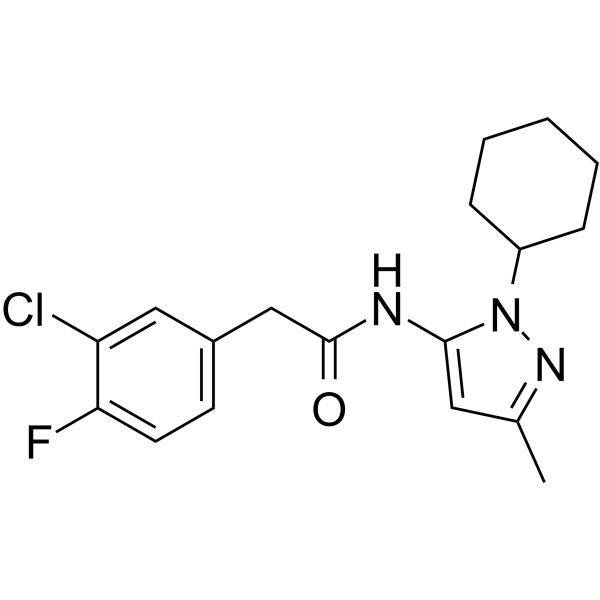
- HY-P10019
-
|
NLY01
|
GCGR
|
Neurological Disease
|
|
Pegsebrenatide (NLY01) is a long-acting GLP-1R agonist. Pegsebrenatide has an extended half-life and favorable blood-brain barrier penetration. Pegsebrenatide can block A1 astrocyte transformation, reducing dopaminergic cell death, and improving motor symptoms in mouse models of PD .
|
-

- HY-161275
-
|
|
EGFR
|
Cancer
|
|
BI-4732 a potent inhibitor EGFR-activating (E19del and L858R) and T790M mutations, with high blood-brian barrier penetration, targeting a broad range of EGFR mutations, including C797S. BI-4732 has anti-tumor activity .
|
-
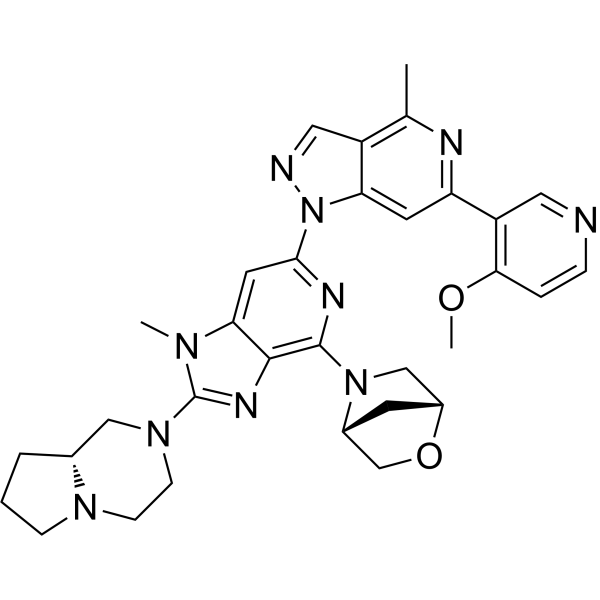
- HY-P0311
-
|
|
Bacterial
|
Infection
|
|
LAH4, an alpha-helix of the designed amphipathic peptide antibiotic, exhibits potent antimicrobial, nucleic acid transfection and cell penetration activities. LAH4 possesses high plasmid DNA delivery capacities. LAH4 has a strong affinity for anionic lipids found in the outer membrane of bacterial membranes .
|
-

- HY-114320
-
|
TM-10
|
Cholinesterase (ChE)
|
Neurological Disease
|
|
BuChE-IN-TM-10 (TM-10) is a potent butyrylcholinesterase (BuChE) inhibitor, with an IC50 of 8.9 nM. BuChE inhibitor 1 inhibits and disaggregates self-induced Aβ aggregation, exhibiting potent antioxidant activity and good blood-brain barrier (BBB) penetration. Has potential to treat Alzheimer’s disease .
|
-
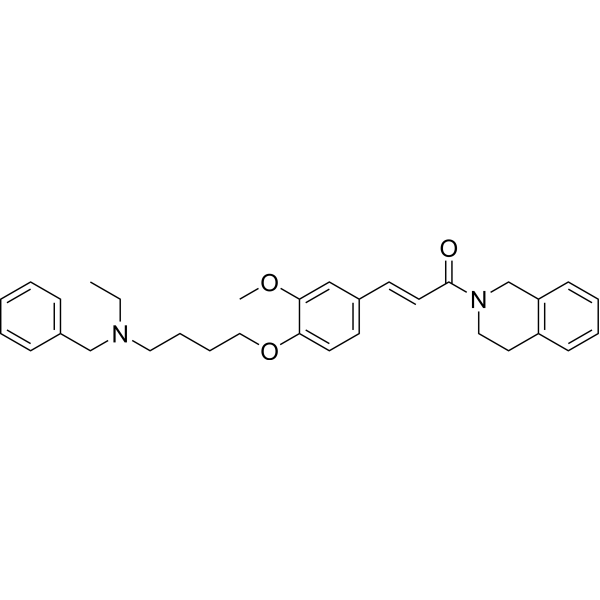
- HY-120574
-
|
|
ADC Cytotoxin
Topoisomerase
|
Cancer
|
|
TH1338 (compound 3b), an orally active camptothecin derivative and a potent chemotherapeutic agent for cancer, demonstrates excellent cytotoxic potency against human tumor cell lines in vitro. TH1338 (compound 3b) possesses significant brain penetration, favorable efflux pump properties, and hematological toxicity profile .
|
-
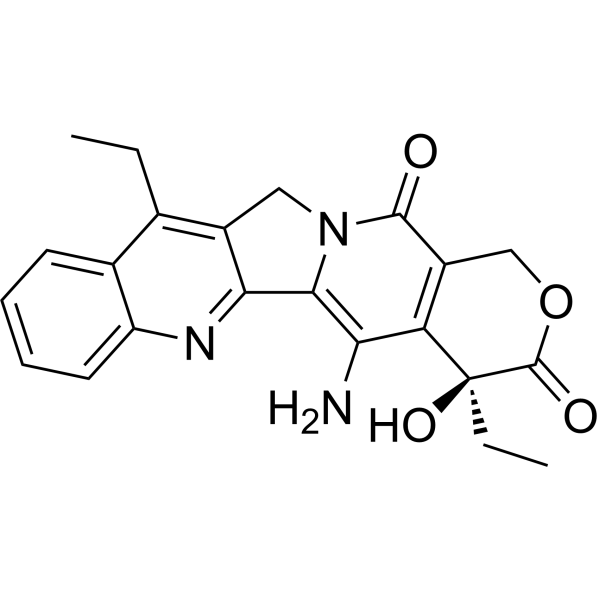
- HY-145086
-
|
|
Others
|
Metabolic Disease
|
|
R-PSOP is highly potent and selective nonpeptidic NMUR2 antagonist. R-PSOP binds to NMUR2 with the Kis of 52 and 32 nM for the human and rat NMUR2, respectively. R-PSOP shows moderate CNS penetration. R-PSOP can be used for the research of the eating disorders, obesity, pain, and stress-related disorders .
|
-
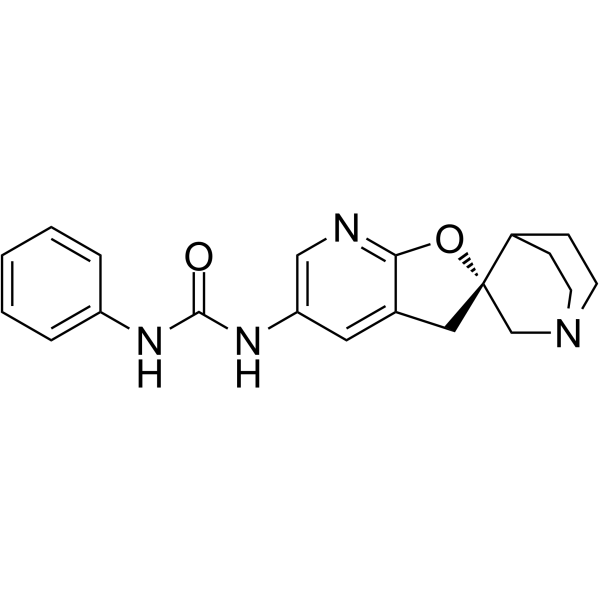
- HY-101834
-
|
|
Orexin Receptor (OX Receptor)
|
Others
|
|
ACT-462206 is an orally active and potent dual Orexin 1/Orexin 2 receptor antagonist with IC50s of 60 nM (Orexin 1) and 11 nM (Orexin 2), respectively. ACT-462206 exhibits brain penetration properties, and can be used for insomnia, stress/anxiety-related disorders and addiction research .
|
-
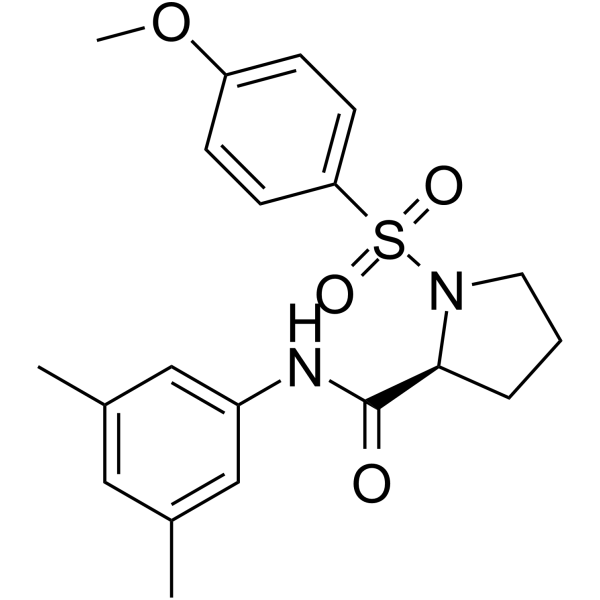
- HY-162351
-
|
|
Others
|
Metabolic Disease
|
|
EBP-IN-1 (compound 11) is an inhibitor of emopamil-binding protein (EBP), a sterol isomerase in the cholesterol biosynthetic pathway. EBP-IN-1 has a long half-life in rodents and has good metabolic turnover and brain penetration properties. EBP-IN-1 enhances oligodendrocyte formation in human cortical organoids .
|
-
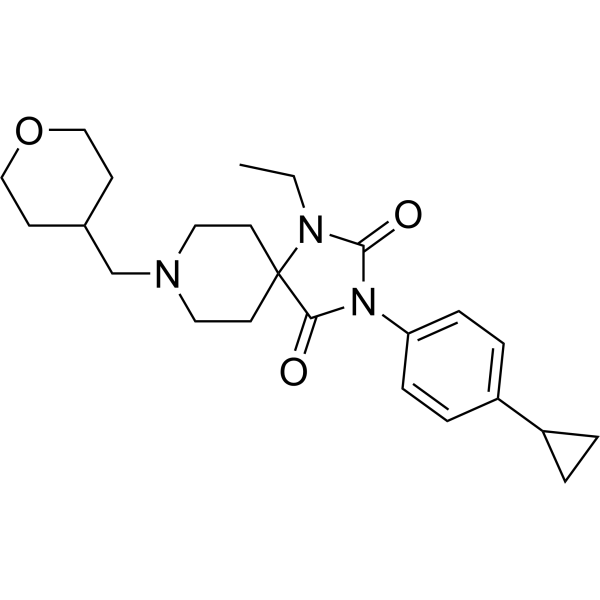
- HY-122559
-
|
|
mGluR
|
Neurological Disease
|
|
BMS-984923, a potent mGluR5 silent allosteric modulator (SAM), with exquisite binding affinity (Ki = 0.6 nM), exhibits good oral bioavailability and BBB penetration. BMS-984923 potently inhibits the PrPC-mGluR5 interaction and prevents pathological Aβo signaling without affecting physiological glutamate signaling .
|
-
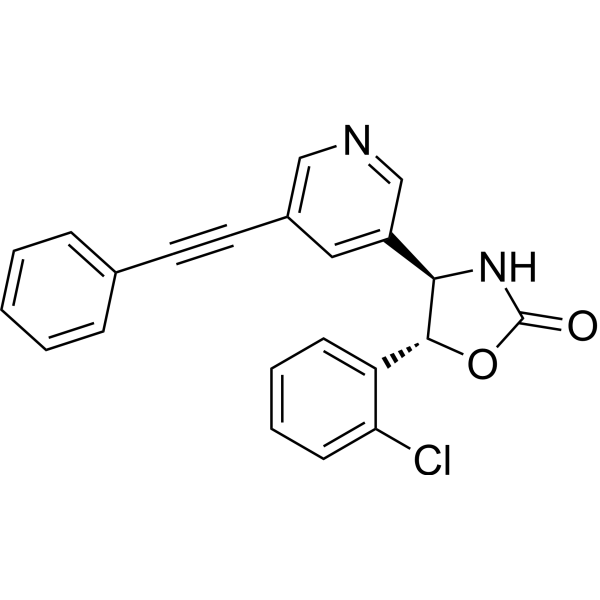
- HY-11045
-
|
|
Histamine Receptor
|
Neurological Disease
Inflammation/Immunology
Endocrinology
|
|
PF-03654746 is a potent and selective histamine H3 receptor antagonist with high brain penetration.
PF-03654746 reduces allergen-induced nasal symptoms, might be a novel therapeutic strategy to further explore allergic rhinitis .
PF-03654746 improves cognitive efficacy and disease-modifying effects in Alzheimer's disease (AD) .
|
-
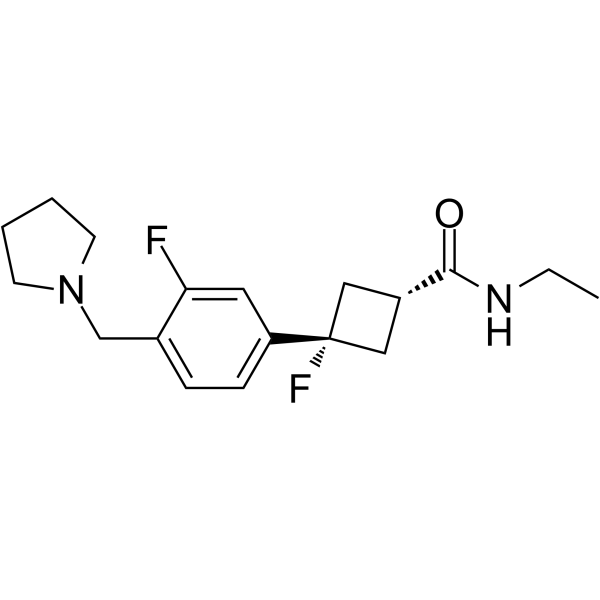
- HY-109189
-
|
BPI-7711
|
EGFR
|
Cancer
|
|
Rezivertinib (BPI-7711) is an orally active, highly selective and irreversible third-generation EGFR tyrosine kinase inhibitor (TKI). Rezivertinib exhibits high potency against the common activation EGFR and the resistance T790M mutations. Rezivertinib has excellent central nervous system (CNS) penetration and has antitumor activity .
|
-
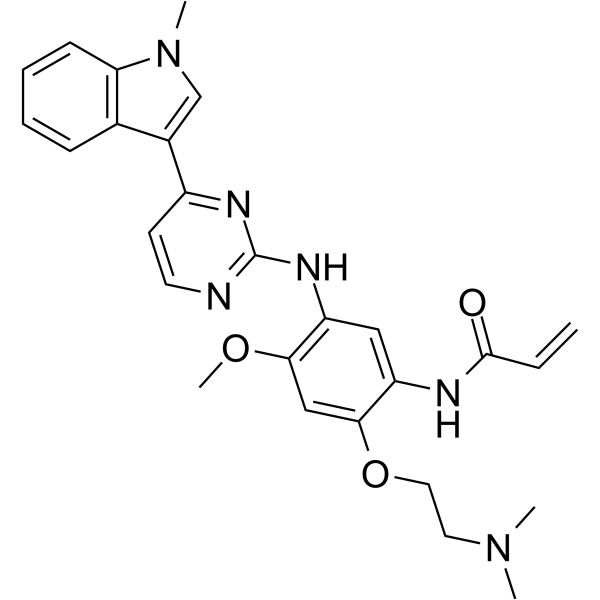
- HY-P0311A
-
|
|
Bacterial
|
Infection
|
|
LAH4 TFA, an alpha-helix of the designed amphipathic peptide antibiotic, exhibits potent antimicrobial, nucleic acid transfection and cell penetration activities. LAH4 TFA possesses high plasmid DNA delivery capacities. LAH4 TFA has a strong affinity for anionic lipids found in the outer membrane of bacterial membranes .
|
-

- HY-15112
-
|
|
Prolyl Endopeptidase (PREP)
|
|
|
JTP-4819 is a potent and specific inhibitor of prolyl endopeptidase (PREP) with IC50s of 0.83 nM (in rat brain supernatant) and 5.43 nM (in Flavobacterium meningosepticum). JTP-4819 has blood-brain penetration, also improves the retention time of amnesia rats induced by Scopolamine (HY-N2096) .
|
-
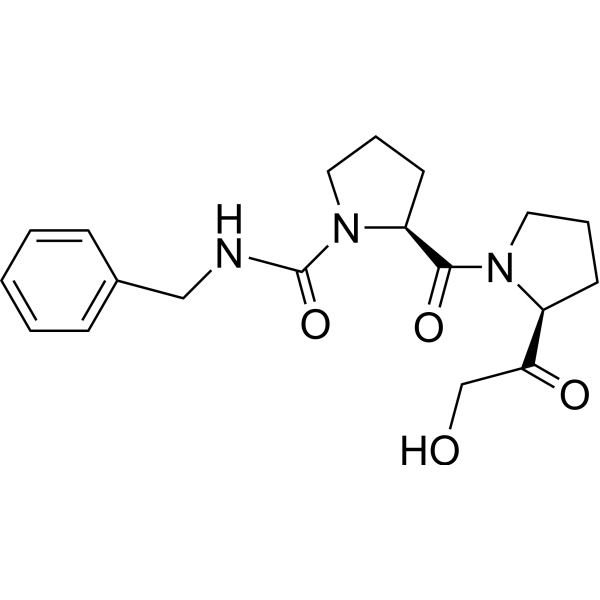
- HY-13011
-
|
CH5424802; RO5424802; RG7853
|
Anaplastic lymphoma kinase (ALK)
|
Cancer
|
|
Alectinib (CH5424802) is a potent, selective, and orally available ALK inhibitor with an IC50 of 1.9 nM and a Kd value of 2.4 nM (in an ATP-competitive manner), and also inhibits ALK F1174L and ALK R1275Q with IC50s of 1 nM and 3.5 nM, respectively . Alectinib demonstrates effective central nervous system (CNS) penetration .
|
-
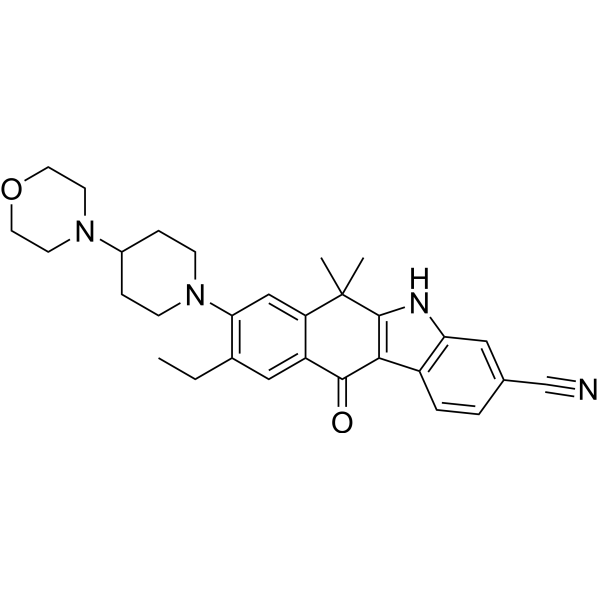
- HY-145906
-
|
|
Dopamine Receptor
|
Neurological Disease
|
|
D4R antagonist-2 is a potent and selective D4R antagonist with an IC50 of 6.52 µM. D4R antagonist-2 displays very favorable in vitro PK parameters and has good brain penetration. D4R antagonist-2 has the potential for the research of Parkinson’s disease .
|
-
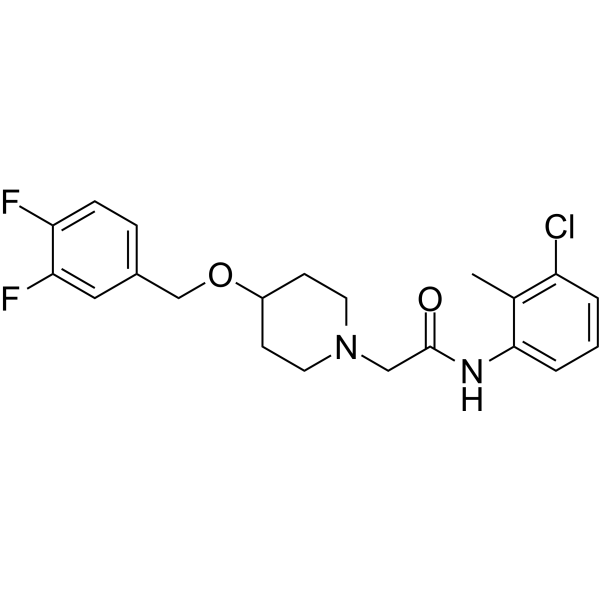
- HY-15196
-
TAK-285
2 Publications Verification
|
EGFR
|
Cancer
|
|
TAK-285 is a potent, selective, ATP-competitive and orally active HER2 and EGFR(HER1) inhibitor with IC50 of 17 nM and 23 nM, respectively. TAK-285 is >10-fold selectivity for HER1/2 than HER4, and less potent to MEK1/5, c-Met, Aurora B, Lck, CSK etc. TAK-285 has effective antitumor activity . TAK-285 can cross the blood-brain barrier (BBB) .
|
-
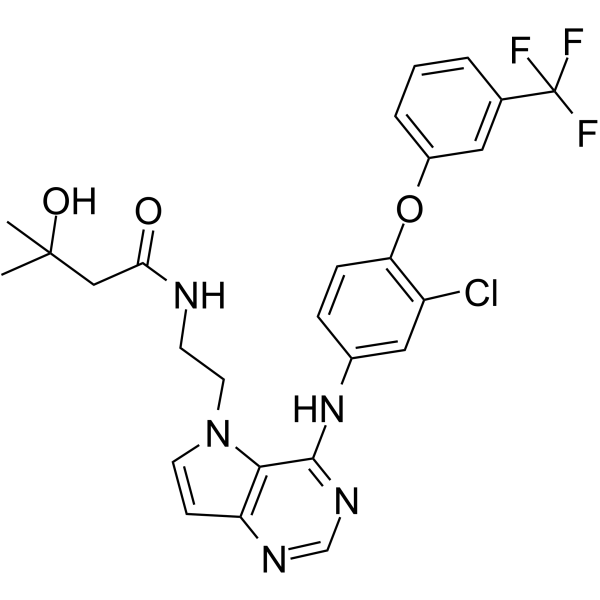
- HY-13788
-
|
|
5-HT Receptor
Adrenergic Receptor
|
Neurological Disease
|
|
LY 344864 is a selective, orally active 5-HT1F receptor agonist with a Ki of 6 nM. LY 344864 is a full agonist producing an effect similar in magnitude to serotonin itself. LY 344864 can cross the blood brain barrier to some extent .
|
-
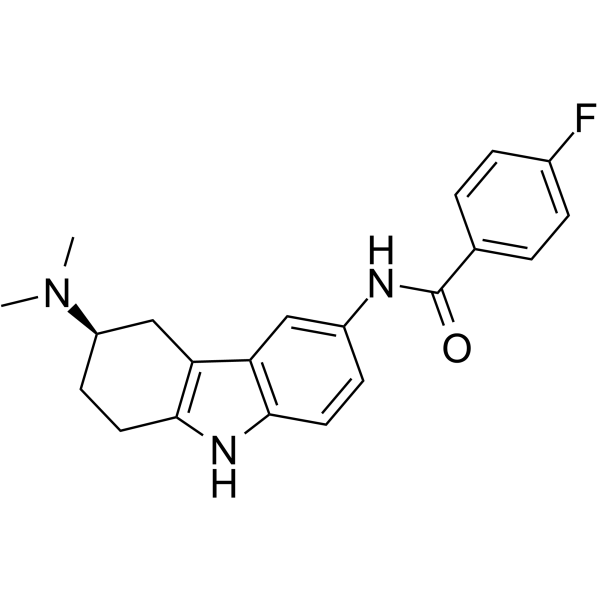
- HY-13788B
-
|
|
5-HT Receptor
Adrenergic Receptor
|
Neurological Disease
|
|
LY 344864 hydrochloride is a selective, orally active 5-HT1F receptor agonist with a Ki of 6 nM. LY 344864 hydrochloride is a full agonist producing an effect similar in magnitude to serotonin itself. LY 344864 hydrochloride can cross the blood brain barrier to some extent .
|
-

- HY-N4134
-
|
|
NO Synthase
|
Inflammation/Immunology
|
|
Ciwujianoside C3, an orally active and brain penetrated compound, is isolated the leaves of Acanthopanax henryi Harms. Ciwujianoside C3 has anti-inflammatory effect and can reinforces object recognition memory .
|
-
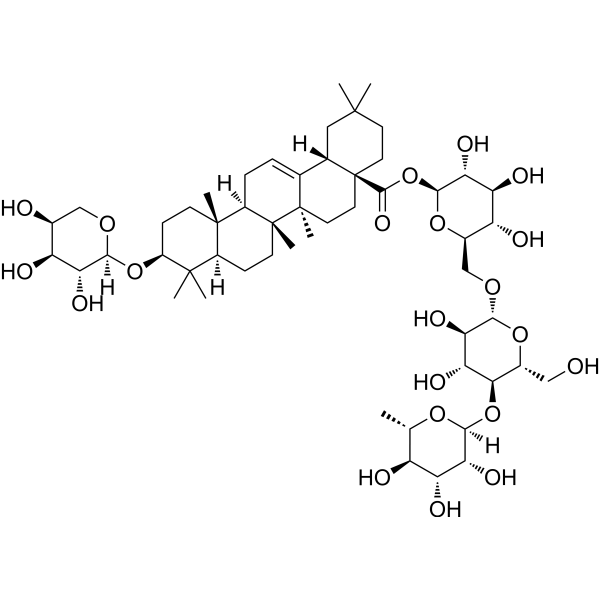
- HY-145695
-
|
|
Cholinesterase (ChE)
Monoamine Oxidase
|
Neurological Disease
|
|
Dual AChE-MAO B-IN-1 (compound 15) is an orally bioavailable CNS-permeant potent inhibitor of both human AChE (IC50=550 nM) and MAO B (IC50=8.2 nM). Dual AChE-MAO B-IN-1 behaves as a safe and metabolically stable neuroprotective agent, devoid of cytochrome liability .
|
-
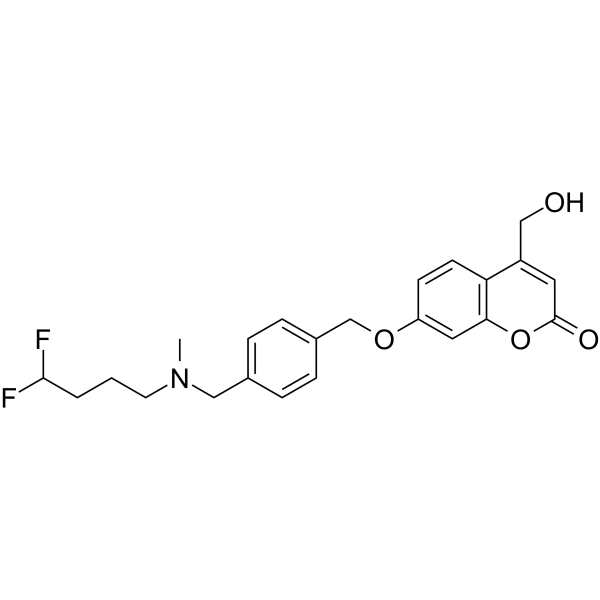
- HY-114331
-
|
|
MAP3K
|
Neurological Disease
|
|
DLK-IN-1 is a selective, orally active inhibitor of dual leucine zipper kinase (DLK, MAP3K12), with a Ki of 3 nM. DLK-IN-1 retains excellent CNS penetration and is well tolerated following multiple days of dosing at concentrations that exceed those required for DLK inhibition in the brain. DLK-IN-1 has activity in a model of Alzheimer’s Disease.
|
-
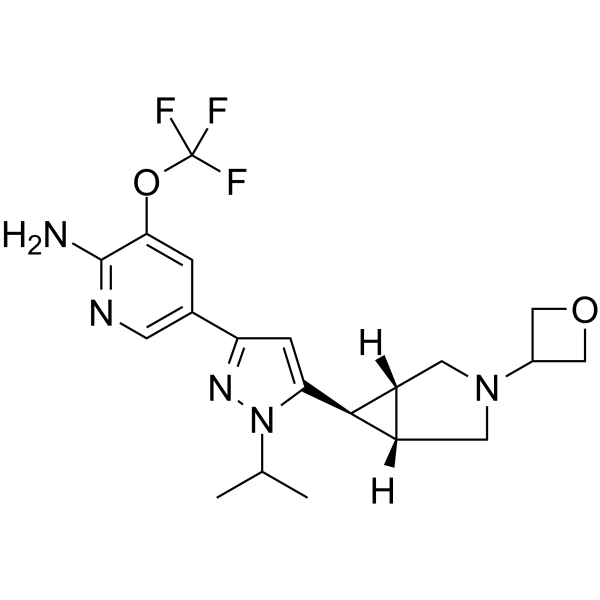
- HY-126429
-
|
|
Sodium Channel
|
Neurological Disease
|
|
Nav1.1 activator 1 (compound 4), a highly potent Nav1.1 activator with BBB penetration, increases decay time constant τ of Nav1.1 currents at 0.03 μM along with significant selectivity against Nav1.2, Nav1.5, and Nav1.6 .
|
-
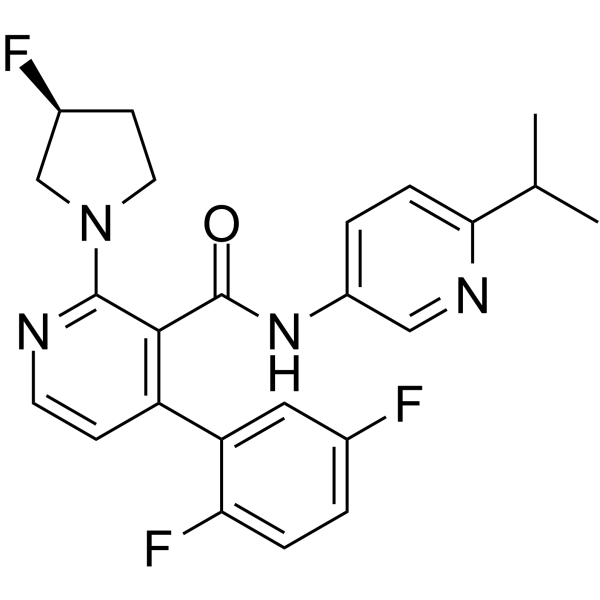
- HY-143413
-
|
|
Amyloid-β
|
Neurological Disease
Inflammation/Immunology
|
|
BuChE-IN-2 is an excellent butyrylcholinesterase (BuChE) inhibitor (IC50s of 1.28 μM and 0.67 μM for BuChE and NO). BuChE-IN-2 can inhibit the aggregation of Aβ, ROS formation and chelate Cu 2+, exhibiting proper blood-brain barrier (BBB) penetration. BuChE-IN-2 has potential to research Alzheimer’s disease .
|
-

- HY-147405
-
|
PF-07284890; ARRY-461
|
Raf
|
Cancer
|
|
Tinlorafenib (PF-07284890) (compound 10) is an orally active BRAF kinase inhibitor, with IC50s of 4.25 and 2.7 nM for BRAF V600E/V600K respectively. Tinlorafenib demonstrates CNS penetration and can be used in the research of BRAF-associated malignant and benign tumors of the CNS as well as extracranial malignancies .
|
-
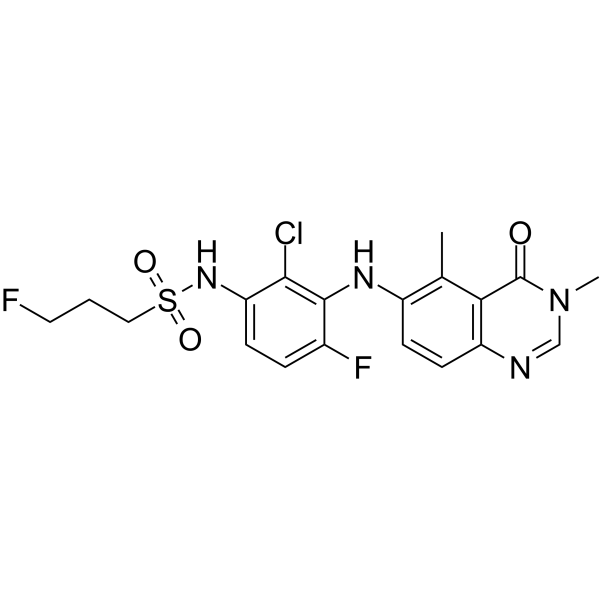
- HY-13011A
-
|
CH5424802 Hydrochloride; RO5424802 Hydrochloride; AF-802 Hydrochloride
|
Anaplastic lymphoma kinase (ALK)
|
Cancer
|
|
Alectinib Hydrochloride (CH5424802 Hydrochloride; RO5424802 Hydrochloride; AF-802 Hydrochloride) is a potent, selective, and orally available ALK inhibitor with an IC50 of 1.9 nM and a Kd value of 2.4 nM (in an ATP-competitive manner), and also inhibits ALK F1174L and ALK R1275Q with IC50s of 1 nM and 3.5 nM, respectively . Alectinib demonstrates effective central nervous system (CNS) penetration .
|
-
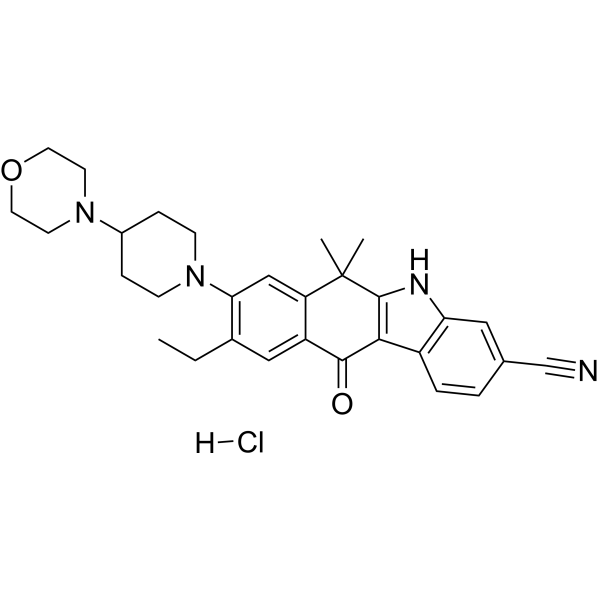
- HY-W395779
-
|
|
Filovirus
|
Infection
|
|
EBOV-IN-1 (com 3.47) is an adamantane dipeptide piperazine and an inhibitor of Ebola virus (EBOV). EBOV-IN-1 targets Niemann-Pick C1 (NPC1) and inhibits its binding to the EBOV glycoprotein (GP) that activates and mediates viral penetration into host cells, thereby inhibiting EBOV infection. EBOV-IN-1 inhibits pseudotyped EBOV infection with an IC50 of 13 nM .
|
-
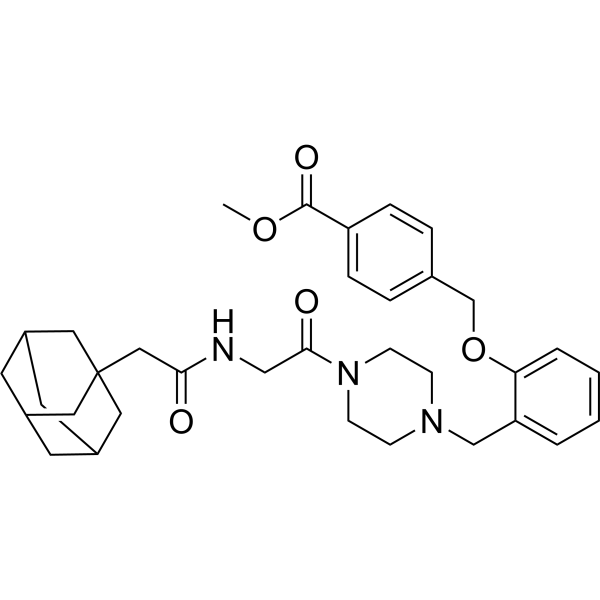
- HY-N4190
-
|
1,6-O,O-Diacetylbritannilactone; Di-O-acetylbritannilactone
|
NO Synthase
|
Neurological Disease
Inflammation/Immunology
|
|
Britannilactone diacetate (1,6-O,O-Diacetylbritannilactone; Compound 2) exhibits potential NO inhibition effect. Britannilactone diacetate exhibits activity against NO production induced by LPS in BV-2 microglial cells with the EC50 value of 6.3 μM. Britannilactone diacetate exhibits a favorable blood-brain barriers (BBB) penetration and absorption, distribution, metabolism, excretion, and toxicity (ADMET) property .
|
-
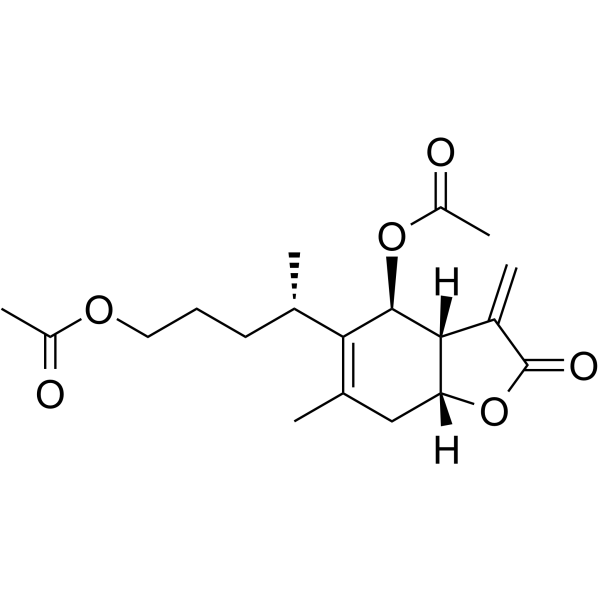
- HY-135478
-
|
NCC1048
|
Calcium Channel
Sodium Channel
|
Neurological Disease
|
|
LY393615 (NCC1048) is a novel neuronal Ca 2+ (calcium channel) and Na + channel (sodium channel) blocker with IC50s of 1.9 μΜ and 5.2 μΜ for α1A and α1B calcium channel subunits. LY393615 has good brain penetration and neuroprotective effects in models of in cerebral ischemia that can be used for neurological disease research .
|
-

- HY-152171
-
|
|
Monoamine Transporter
|
Neurological Disease
|
|
GZ-11608 is a potent and selective vesicular monoamine transporter-2 (VMAT2) inhibitor with high affinity (Ki = 25 nM). GZ-11608 decreases methamphetamine-induced dopamine release from isolated synaptic vesicles from brain dopaminergic neurons. GZ-11608 exhibits rapid brain penetration and without neurotoxicity. GZ-11608 can be used for the research of methamphetamine use disorder .
|
-
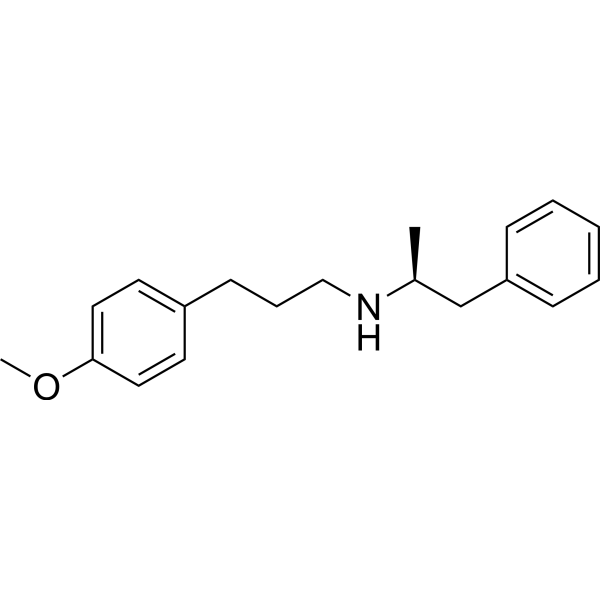
- HY-14325
-
|
|
Dopamine Receptor
|
Neurological Disease
|
|
L-745870 is a potent, selective, brain-penetrant and orally active dopamine D4 receptor antagonist with a Ki of 0.43 nM. L-745870 shows weaker affinity for D2 (Ki of 960 nM) and D3 (Ki of 2300 nM) receptors, and exhibits moderate affinity for 5-HT2 receptors, sigma sites and α-adrenoceptors .
|
-
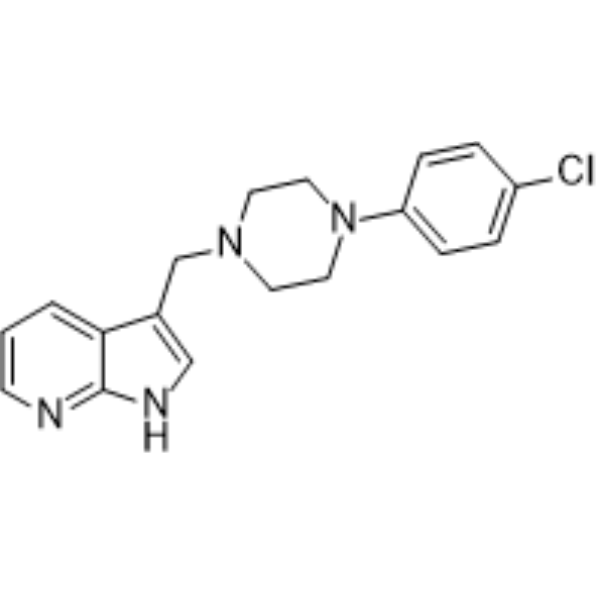
- HY-14325B
-
|
|
Dopamine Receptor
|
Neurological Disease
|
|
L-745870 hydrochloride is a potent, selective, brain-penetrant and orally active dopamine D4 receptor antagonist with a Ki of 0.43 nM. L-745870 hydrochloride shows weaker affinity for D2 (Ki of 960 nM) and D3 (Ki of 2300 nM) receptors, and exhibits moderate affinity for 5-HT2 receptors, sigma sites and α-adrenoceptors .
|
-
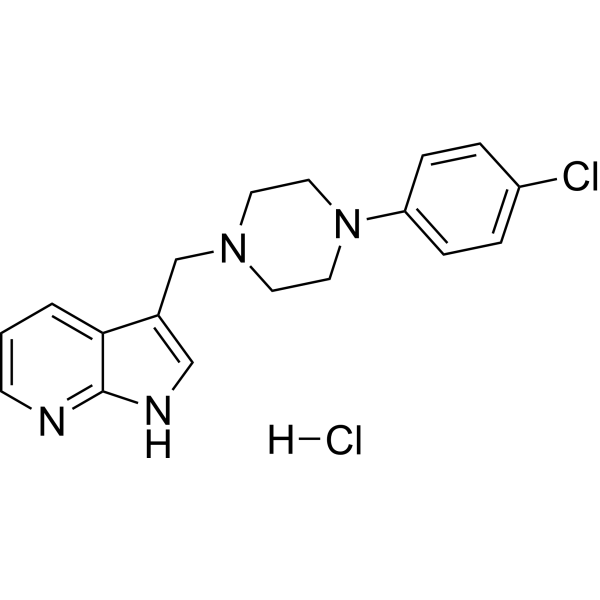
- HY-144372
-
|
|
TRP Channel
|
Neurological Disease
|
|
TRPV1 antagonist 3 (Compound 7q) is a potent TRPV1 antagonist with an IC50 of 2.66 nM against capsaicin. TRPV1 antagonist 3 is mode-selective, oral bioavailable (F = 60%) and CNS-penetrant .
|
-

- HY-110191
-
|
|
mGluR
|
Neurological Disease
Cancer
|
|
VU0469650 is a potent, selective and CNS-penetrated negative allosteric modulator of mGlu1 receptor, with an IC50 of 99 nM .
|
-

- HY-115340
-
|
|
Biochemical Assay Reagents
|
Others
|
|
Decanoic acid sodium, also known as Decanoic acid sodium, is a salt of the fatty acid capric acid. It is easily soluble in water and has a slightly soapy smell. Decanoic acid sodium acts as a penetration enhancer, which means it increases the absorption and bioavailability of drugs across biological membranes, including the intestinal epithelium and the blood-brain barrier. This property makes it useful in pharmaceutical formulations to improve drug delivery and effectiveness. Furthermore, Decanoic acid sodium has potential applications in food preservatives and cosmetics due to its antibacterial properties.
|
-

- HY-155992
-
|
|
Sigma Receptor
|
Neurological Disease
|
|
WLB-89462 (Compound 20c) is a selective σ2 receptor ligand (Ki: 13 nM). WLB-89462 has neuroprotective activity. WLB-89462 improves short-term memory impairment induced by Aβ peptide in rats. WLB-89462 has good ADMET profile (good solubility, no CYP inhibition, good metabolic stability, high permeability, brain penetration, and high oral exposure in rodents) .
|
-

- HY-144309
-
|
|
Cytochrome P450
|
Neurological Disease
|
|
Cholesterol 24-hydroxylase-IN-1 (compound 17) is a potent, orally active, and highly selective cholesterol 24-hydroxylase (CH24H or CYP46A1) inhibitor (IC50=8.5 nM). Cholesterol 24-hydroxylase-IN-1 can cross blood-brain barrier .
|
-
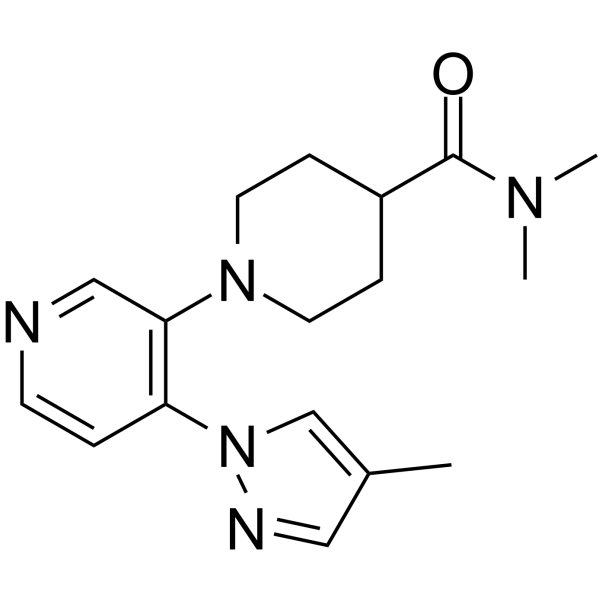
- HY-16712
-
|
|
TGF-β Receptor
|
Cancer
|
|
LDN-214117 is an orally active ALK2 inhibitor with well-tolerated and good brain penetration. LDN-214117 has a high selectivity and low cytotoxicity for ALK2 with an IC50 value of 24 nM. LDN-214117 also is a specific bone morphogenetic proteins (BMPs) signaling inhibitor and has relatively selective inhibition for BMP6 with an IC50 value of 100 nM. LDN-214117 can be used for the research of fibrodysplasia ossificans progressiva (FOP), diffuse intrinsic pontine glioma (DIPG) [2]
|
-

- HY-115925
-
|
|
SHP2
Phosphatase
|
Cancer
|
|
SHP2-IN-9 is a specific SHP2 inhibitor (IC50 =1.174 μM) with enhanced blood–brain barrier penetration. SHP2-IN-9 shows 85-fold more selective for SHP2 than SHP1. SHP2-IN-9 inhibits SHP2-mediated cell signal transduction and cancer cell proliferation, and inhibits the growth of cervix cancer tumors and glioblastoma growth in vivo .
|
-

- HY-B0250
-
|
BCH-189
|
HIV
Reverse Transcriptase
HBV
|
Infection
Cancer
|
|
Lamivudine (BCH-189) is an orally active nucleoside reverse transcriptase inhibitor (NRTI). Lamivudine can inhibit HIV reverse transcriptase 1/2 and also the reverse transcriptase of hepatitis B virus. Lamivudine salicylate can penetrate the CNS .
|
-

- HY-130795
-
|
|
GSK-3
|
Neurological Disease
|
|
GSK-3β inhibitor 2 (Compound 3) is a potent, selective and orally active GSK-3β inhibitor with an IC50 of 1.1 nM. GSK-3β inhibitor 2 can cross the blood-brain barrier. GSK-3β inhibitor 2 has the potential for Alzheimer's disease .
|
-
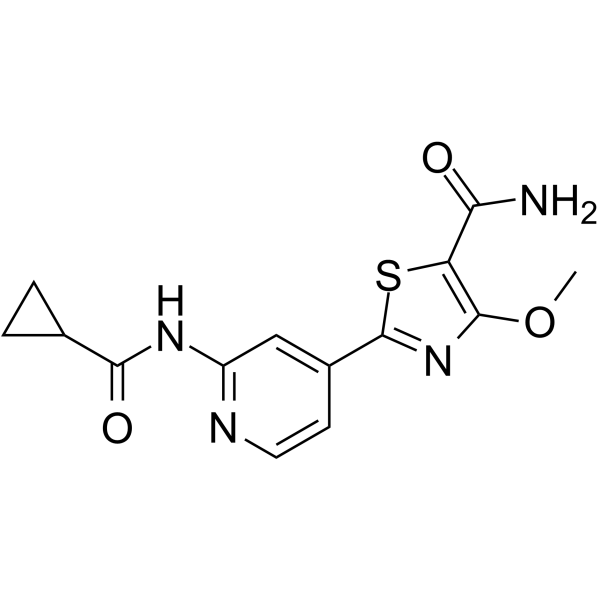
- HY-150503
-
|
|
HDAC
|
Neurological Disease
|
|
KH-259 (compound 1) is a potent, selective and CNS-penetrant HDAC6 inhibitor, with an IC50 of 0.26 μM. KH-259 has antidepressant effects in mice through the inhibition of HDAC6 in the brain. KH-259 can be used for neurodegenerative diseases research .
|
-
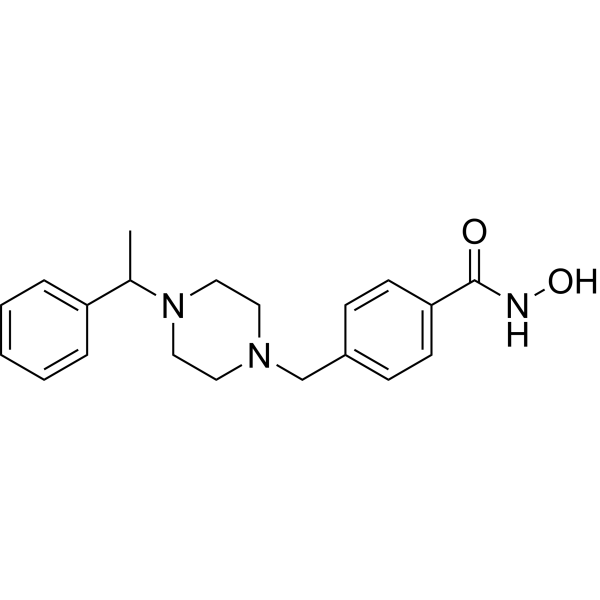
- HY-B0250S1
-
|
BCH-189-13C,15N2,d2
|
Isotope-Labeled Compounds
HBV
Reverse Transcriptase
HIV
|
Infection
|
|
Lamivudine-13C,15N2,d2 (BCH-189-13C,15N2,d2) is a 13C, 15N, and deuterium labeled Lamivudine (HY-B0250). Lamivudine is an orally active and blood-brain barrier permeable nucleoside reverse transcriptase inhibitor (NRTI). Lamivudine inhibits HIV reverse transcriptase 1 and 2 and hepatitis B virus (HBV) reverse transcriptase .
|
-

- HY-133551
-
|
|
RET
|
Cancer
|
|
WF-47-JS03 is a potent and selective RET kinase inhibitor with IC50s of 1.7 nM and 5.3 nM for KIF5B-RET transfected Ba/F3 cells and CCDC6-RET transfected LC-2/ad lung cancer cells, respectively. WF-47-JS03 demonstrates >500-fold selectivity against kinase insert domain receptor (KDR). Effective brain penetration .
|
-

- HY-W099581
-
|
Zwittergent 3-14
|
Biochemical Assay Reagents
|
Others
|
|
Zwittergent 3-14 (DMAPS) is a zwitterionic detergent commonly used in biochemistry and molecular biology for the solubilization and purification of membrane-bound proteins and other hydrophobic biomolecules, which have both hydrophilic and hydrophobic moieties , so that it has good detergency properties, making it suitable for stabilizing membrane proteins in aqueous solutions. In addition, DMAPS has been used in various techniques such as electrophoresis and chromatography for the separation and analysis of biomolecules. The long The hydrocarbon chains provide it with good membrane penetration and solubilization capabilities, while the sulfonate and quaternary ammonium groups ensure water solubility and charge neutrality.
|
-
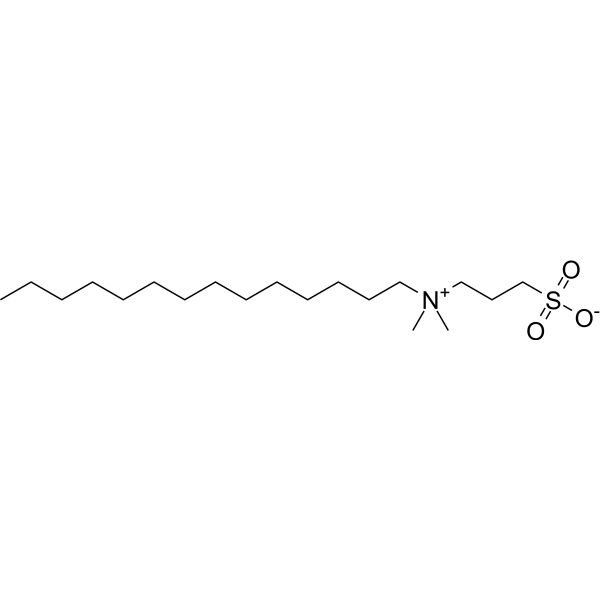
- HY-118834
-
|
Lyngbyatoxin A
|
PKC
|
Cancer
|
|
Teleocidin A1 (Lyngbyatoxin A), a highly toxic skin irritant, is a potent activator of protein kinase C (PKC). Teleocidin A1 shows antiproliferative activity against HeLa cancer cells (IC50=9.2 nM) .
|
-
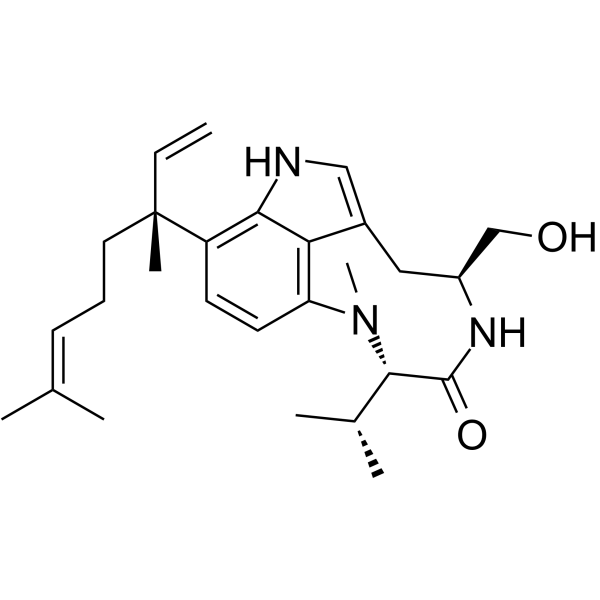
- HY-134524
-
|
Dimethyl isosorbide; O,O-Dimethylisosorbide
|
Biochemical Assay Reagents
|
Others
|
|
Isosorbide dimethyl ether is a biobased high boiling green solvent. Isosorbide dimethyl ether can be used for sustainable ultrafiltration and microfiltration membrane preparation. Isosorbide dimethyl ether can be used as an excipient, such as solvent, penetration aid. Pharmaceutical excipients, or pharmaceutical auxiliaries, refer to other chemical substances used in the pharmaceutical process other than pharmaceutical ingredients. Pharmaceutical excipients generally refer to inactive ingredients in pharmaceutical preparations, which can improve the stability, solubility and processability of pharmaceutical preparations. Pharmaceutical excipients also affect the absorption, distribution, metabolism, and elimination (ADME) processes of co-administered drugs .
|
-

- HY-157998
-
|
|
mGluR
Src
|
Others
|
|
mG2N001 is a negative allosteric modulator (NAM) (IC50: 93 nM) of the metabotropic glutamate receptor mGluR2 and binds to mGluR2 as an antagonist (Ki: 63 nM). mG2N001 is microparticle- and plasma-stable, and its radioisotope [11C]mG2N001 can be used in PET imaging. [11C]mG2N001 has good brain heterogeneity and brain penetration, and can selectively accumulate in mGluR2-rich regions, producing high-contrast brain images .
|
-
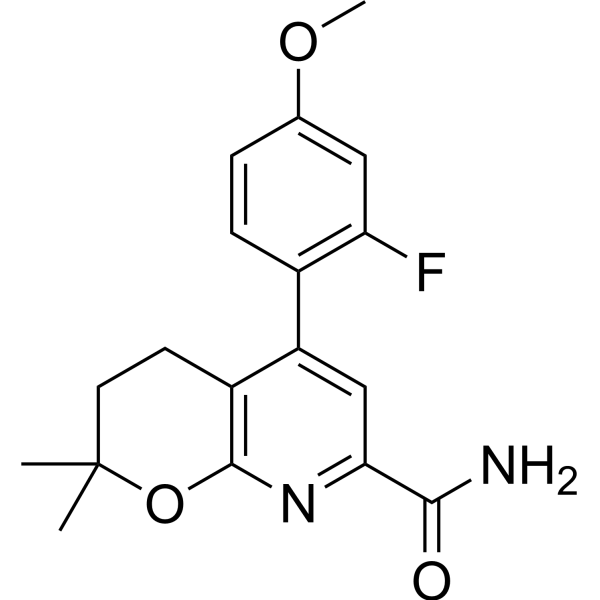
- HY-Y0320
-
|
DMSO
|
Bacterial
Cholinesterase (ChE)
|
Infection
Inflammation/Immunology
Cancer
|
Dimethyl sulfoxide (DMSO) is an aprotic solvent that dissolves polar and non-polar compounds, including water-insoluble therapeutic and toxic agents. Dimethyl sulfoxide (DMSO) has a strong affinity for water and can rapidly penetrate or enhance the penetration of other substances into biological membranes. Dimethyl sulfoxide also has potential free radical scavenging and anticholinesterase effects and may affect coagulation activity. Dimethyl sulfoxide also induces histamine release from mast cells but is thought to have low systemic toxicity. Dimethyl sulfoxide also exhibits antifreeze and antibacterial properties .
MCE provides Dimethyl sulfoxide that complies with the inspection standards (Ch.P) of Part 4 of the Chinese Pharmacopoeia (2020 Edition).
|
-

- HY-146201
-
|
|
Phosphodiesterase (PDE)
|
Others
|
|
1 a /5-hydroxynitrile rubber 7 receptor antagonist (5-HT1 a k i = 8 nm, kb= 0.04 nm; 5-nitrile rubber 7K I = 451 nm, kb= 460 nm) has pde4b/pde7a inhibitory activity (PDE4B ic50= 80.4 μ M; Pde7a chip 50= 151.3 μ M)。 Compound 22 has a very good ability of passive penetration of biofilm and high metabolic stability in vitro. In addition, 22's pharmacological evaluation showed its pre cognitive and antidepressant properties in rat behavioral tests.
|
-
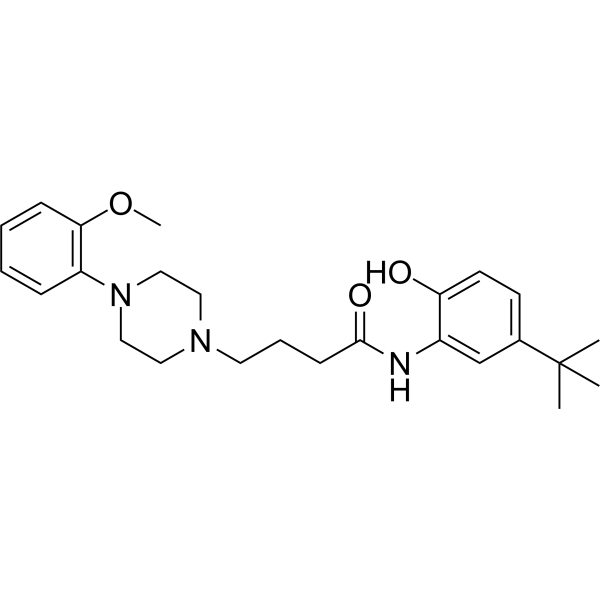
- HY-105685
-
|
|
Vasopressin Receptor
|
Neurological Disease
|
|
SRX246 is a potent, CNS-penetrant, highly selective, orally bioavailable vasopressin 1a (V1a) receptor antagonist (Ki=0.3 nM for human V1a). SRX246 has no interaction at V1b and V2 receptors. SRX246 also displays negligible binding at 64 others receptors classes, including 35 G-proteincoupled receptors. SRX246 can be used for treatment of stress-related disorders .
|
-
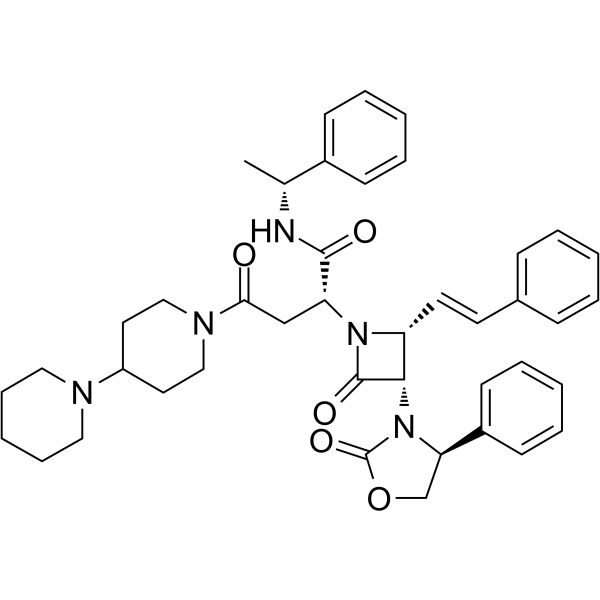
- HY-13637
-
|
BW 759; 2'-Nor-2'-deoxyguanosine
|
CMV
HSV
Antibiotic
Nucleoside Antimetabolite/Analog
|
Infection
Cancer
|
|
Ganciclovir (BW 759), a nucleoside analogue, is an orally active antiviral agent with activity against CMV. Ganciclovir also has activity in vitro against members of the herpes group and some other DNA viruses. Ganciclovir inhibits the in vitro replication of human herpes viruses (HSV 1 and 2, CMV) and adenovirus serotypes 1, 2, 4, 6, 8, 10, 19, 22 and 28. Ganciclovir has an IC50 of 5.2 μM for feline herpesvirus type-1 (FHV-1) and can diffuse into the brain .
|
-
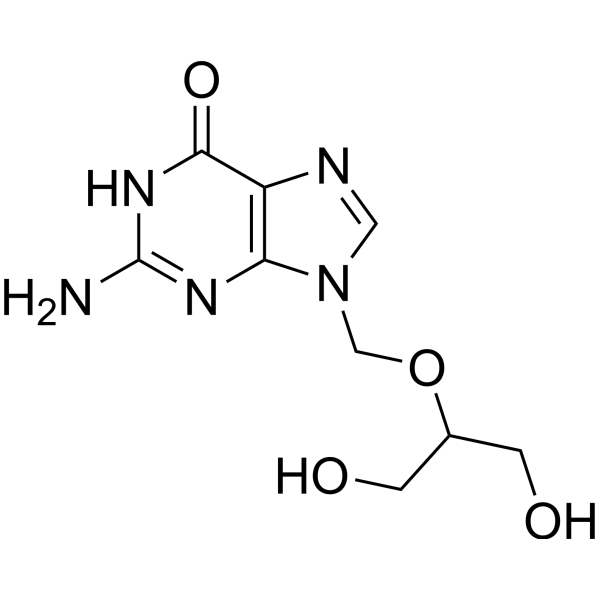
- HY-13637B
-
|
BW-759 hydrate; 2'-Nor-2'-deoxyguanosine hydrate
|
CMV
HSV
Antibiotic
Nucleoside Antimetabolite/Analog
|
Infection
Cancer
|
|
Ganciclovir (BW 759) hydrate, a nucleoside analogue, is an orally active antiviral agent with activity against CMV. Ganciclovir hydrate also has activity in vitro against members of the herpes group and some other DNA viruses. Ganciclovir hydrate inhibits the in vitro replication of human herpes viruses (HSV 1 and 2, CMV) and adenovirus serotypes 1, 2, 4, 6, 8, 10, 19, 22 and 28. Ganciclovir hydrate has an IC50 of 5.2 μM for feline herpesvirus type-1 (FHV-1) and can diffuse into the brain .
|
-
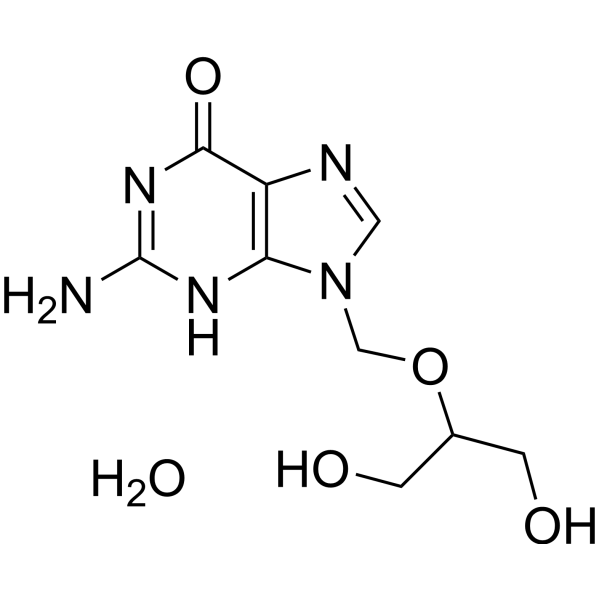
- HY-12624
-
|
ON123300
|
CDK
AMPK
PDGFR
|
Cancer
|
|
Narazaciclib (ON123300), a strong and brain-penetrant multi-kinase inhibitor, inhibits CDK4 (IC50=3.9 nM), Ark5 (IC50=5 nM), PDGFRβ (IC50=26 nM), FGFR1 (IC50=26 nM), RET (IC50=9.2 nM), and FYN (IC50=11 nM). Single agent Narazaciclib causes a dose-dependent suppression of phosphorylation of Akt as well as activation of Erk in brain tumors . Narazaciclib inhibits CDK6 with an IC50 of 9.82 nM .
|
-
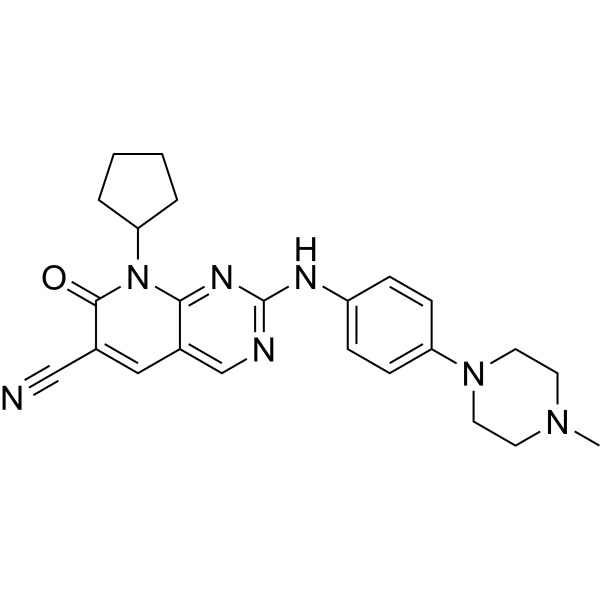
| Cat. No. |
Product Name |
Type |
-
- HY-D1392
-
|
Ag2Te
|
Quantum Dots
|
|
Ag2Te QDs (Ag2Te) is an effective biological probe in the second near-infrared window (NIR-II) that can be used in bioimaging with high tissue penetration depth and high spatiotemporal resolution .
|
-
- HY-D1393
-
|
Pb:Ag2Se
|
Quantum Dots
|
|
Pb:Ag2Se QDs (Pb:Ag2Se) is an effective biological probe in the second near-infrared window (NIR-II) that can be used in bioimaging with high tissue penetration depth and high spatiotemporal resolution .
|
| Cat. No. |
Product Name |
Type |
-
- HY-W110888
-
|
|
Biochemical Assay Reagents
|
|
Brilliant Yellow, a diazo-containing sulfonic aci, is also a potent VGLUT-specific inhibitor. Brilliant Yellow is membrane-impermeable. However, there are some Brilliant Yellow analogs with low cytotoxicity and cell penetration. Brilliant Yellow analogs work on glutamatergic transmission in hippocampal neurons .
|
-
- HY-115340
-
|
|
Biochemical Assay Reagents
|
|
Decanoic acid sodium, also known as Decanoic acid sodium, is a salt of the fatty acid capric acid. It is easily soluble in water and has a slightly soapy smell. Decanoic acid sodium acts as a penetration enhancer, which means it increases the absorption and bioavailability of drugs across biological membranes, including the intestinal epithelium and the blood-brain barrier. This property makes it useful in pharmaceutical formulations to improve drug delivery and effectiveness. Furthermore, Decanoic acid sodium has potential applications in food preservatives and cosmetics due to its antibacterial properties.
|
-
- HY-W099581
-
|
Zwittergent 3-14
|
Biochemical Assay Reagents
|
|
Zwittergent 3-14 (DMAPS) is a zwitterionic detergent commonly used in biochemistry and molecular biology for the solubilization and purification of membrane-bound proteins and other hydrophobic biomolecules, which have both hydrophilic and hydrophobic moieties , so that it has good detergency properties, making it suitable for stabilizing membrane proteins in aqueous solutions. In addition, DMAPS has been used in various techniques such as electrophoresis and chromatography for the separation and analysis of biomolecules. The long The hydrocarbon chains provide it with good membrane penetration and solubilization capabilities, while the sulfonate and quaternary ammonium groups ensure water solubility and charge neutrality.
|
-
- HY-Y0320
-
|
DMSO
|
Co-solvents
|
Dimethyl sulfoxide (DMSO) is an aprotic solvent that dissolves polar and non-polar compounds, including water-insoluble therapeutic and toxic agents. Dimethyl sulfoxide (DMSO) has a strong affinity for water and can rapidly penetrate or enhance the penetration of other substances into biological membranes. Dimethyl sulfoxide also has potential free radical scavenging and anticholinesterase effects and may affect coagulation activity. Dimethyl sulfoxide also induces histamine release from mast cells but is thought to have low systemic toxicity. Dimethyl sulfoxide also exhibits antifreeze and antibacterial properties .
MCE provides Dimethyl sulfoxide that complies with the inspection standards (Ch.P) of Part 4 of the Chinese Pharmacopoeia (2020 Edition).
|
| Cat. No. |
Product Name |
Target |
Research Area |
-
- HY-P5398
-
|
|
Peptides
|
Others
|
|
HR2-18 is a biological active peptide. (inhibition of SARS-CoV penetration into cells.)
|
-
- HY-P10157
-
|
|
Peptides
|
Others
|
|
ARF(1-22) is potentially capable of intracellular penetration to deliver small molecules, proteins, imaging agents, and pharmaceutical nanocarriers .
|
-
- HY-P4135
-
|
|
Peptides
|
Others
|
|
FITC-LC-Antennapedia Peptide is a FITC labeled Antennapedia Peptide (HY-P0307). Antennapedia Peptide is a cellular-membrane permeable peptides (CPP). FITC-LC-Antennapedia Peptide has good penetration in 3T3 cell line, which was rapidly accumulated into nuclei .
|
-
- HY-P10019
-
|
NLY01
|
GCGR
|
Neurological Disease
|
|
Pegsebrenatide (NLY01) is a long-acting GLP-1R agonist. Pegsebrenatide has an extended half-life and favorable blood-brain barrier penetration. Pegsebrenatide can block A1 astrocyte transformation, reducing dopaminergic cell death, and improving motor symptoms in mouse models of PD .
|
-
- HY-P0311
-
|
|
Bacterial
|
Infection
|
|
LAH4, an alpha-helix of the designed amphipathic peptide antibiotic, exhibits potent antimicrobial, nucleic acid transfection and cell penetration activities. LAH4 possesses high plasmid DNA delivery capacities. LAH4 has a strong affinity for anionic lipids found in the outer membrane of bacterial membranes .
|
-
- HY-P0311A
-
|
|
Bacterial
|
Infection
|
|
LAH4 TFA, an alpha-helix of the designed amphipathic peptide antibiotic, exhibits potent antimicrobial, nucleic acid transfection and cell penetration activities. LAH4 TFA possesses high plasmid DNA delivery capacities. LAH4 TFA has a strong affinity for anionic lipids found in the outer membrane of bacterial membranes .
|
-
- HY-66015
-
|
|
Peptides
|
Others
|
|
Palmitoyl hexapeptide-12 is a bioactive peptide with anti-aging effect and has been reported used as a cosmetic ingredient .
|
-
- HY-107380A
-
|
A-42872 TFA
|
Peptides
|
Endocrinology
|
|
PGlu-3-methyl-His-Pro-NH2 TFA (A-42872 TFA), the modified thyrotropin-releasing hormone (TRH) peptide, enhances binding to pituitary TRH receptors and increases stimulation of thyroid-stimulating hormone (TSH) release from the pituitary. The in vitro permeability of PGlu-3-methyl-His-Pro-NH2 TFA through rat skin is increased in the presence of enhancers Ethanol and Cineole .
|
-
- HY-P5270
-
|
|
Peptides
|
Metabolic Disease
|
|
Hexapeptide-12isa bioactive peptide with anti-aging effect and has been reported used as a cosmetic ingredient .
|
| Cat. No. |
Product Name |
Target |
Research Area |
-
- HY-P9967
-
|
BIIB037
|
Amyloid-β
|
Neurological Disease
|
|
Aducanumab (BIIB037) is a human monoclonal antibody that selectively targets aggregated amyloid-beta (Aβ). Aducanumab shows brain penetration, and can be used for Alzheimer's disease (AD) research .
|
-
- HY-P99565
-
|
ARENEGYR; NGR-TNF; NGR-hTNF
|
TNF Receptor
|
Cancer
|
|
Tengonermin (ARENEGYR) is a vascular-targeting agent consisting of the human Tumour Necrosis Factor-α (TNF-α) conjugated with the CNGRCG peptide. Tengonermin increases penetration of intratumoral chemotherapy and T-cell infiltration by modifying the tumour microenvironment .
|
| Cat. No. |
Product Name |
Category |
Target |
Chemical Structure |
| Cat. No. |
Product Name |
Chemical Structure |
-
- HY-13011S
-
|
|
|
Alectinib-d8 is the deuterium labeled Alectinib. Alectinib (CH5424802) is a potent, selective, and orally available ALK inhibitor with an IC50 of 1.9 nM and a Kd value of 2.4 nM (in an ATP-competitive manner), and also inhibits ALK F1174L and ALK R1275Q with IC50s of 1 nM and 3.5 nM, respectively[1]. Alectinib demonstrates effective central nervous system (CNS) penetration[2].
|
-

-
- HY-13011S1
-
|
|
|
Alectinib-d6 is deuterium labeled Alectinib. Alectinib (CH5424802) is a potent, selective, and orally available ALK inhibitor with an IC50 of 1.9 nM and a Kd value of 2.4 nM (in an ATP-competitive manner), and also inhibits ALK F1174L and ALK R1275Q with IC50s of 1 nM and 3.5 nM, respectively[1]. Alectinib demonstrates effective central nervous system (CNS) penetration[2].
|
-

-
- HY-B0250S1
-
|
|
|
Lamivudine-13C,15N2,d2 (BCH-189-13C,15N2,d2) is a 13C, 15N, and deuterium labeled Lamivudine (HY-B0250). Lamivudine is an orally active and blood-brain barrier permeable nucleoside reverse transcriptase inhibitor (NRTI). Lamivudine inhibits HIV reverse transcriptase 1 and 2 and hepatitis B virus (HBV) reverse transcriptase .
|
-

| Cat. No. |
Product Name |
|
Classification |
-
- HY-139300A
-
|
HMPL-813 succinate
|
|
Alkynes
|
|
Epitinib succinate is an orally active and selective epidermal growth factor receptor tyrosine kinase inhibitor (EGFR-TKI) designed for optimal brain penetration. Epitinib succinate can be used for the research of cancer . Epitinib (succinate) is a click chemistry reagent, it contains an Alkyne group and can undergo copper-catalyzed azide-alkyne cycloaddition (CuAAc) with molecules containing Azide groups.
|
-
- HY-139300
-
|
HMPL-813
|
|
Alkynes
|
|
Epitinib is an orally active and selective epidermal growth factor receptor tyrosine kinase inhibitor (EGFR-TKI) designed for optimal brain penetration. Epitinib can be used for the research of cancer . Epitinib is a click chemistry reagent, it contains an Alkyne group and can undergo copper-catalyzed azide-alkyne cycloaddition (CuAAc) with molecules containing Azide groups.
|
Your information is safe with us. * Required Fields.
Inquiry Information
- Product Name:
- Cat. No.:
- Quantity:
- MCE Japan Authorized Agent:











































































































































